CANCER CARE FOR ALL
Rays of Hope: new initiative to bring cancer care for all, pg 4
A pathway of hope: guidance on setting up cancer centres, pg 8
Unlocking the power of partnerships and innovative financing for improved access to cancer care, pg 10
INTERNATIONAL ATOMIC ENERGY AGENCY IA E A BULL
The IAEA’s flagship publication | February 2022 | www.iaea.org/bulletin
E TI N
IAEA BULLETIN is produced by the Office of Public Information and Communication (OPIC)
International Atomic Energy Agency
Vienna International Centre PO Box 100, 1400 Vienna, Austria Phone: (43-1) 2600-0 iaeabulletin@iaea.org
Managing Editor: Michael Amdi Madsen
Editor: Miklos Gaspar
Design & Production: Ritu Kenn
IAEA BULLETIN is available online at www.iaea.org/bulletin
Extracts from the IAEA material contained in the IAEA Bulletin may be freely used elsewhere provided acknowledgement of their source is made. If the attribution indicates that the author is not an IAEA staff member, permission to republish other than for the use of review must be sought from the author or originating organization.
Views expressed in any signed article appearing in the IAEA Bulletin do not necessarily represent those of the International Atomic Energy Agency and the IAEA accepts no responsibility for them.
Cover: IAEA
The International Atomic Energy Agency’s mission is to prevent the spread of nuclear weapons and to help all countries — especially in the developing world — benefit from the peaceful, safe and secure use of nuclear science and technology.

Established as an autonomous organization under the United Nations in 1957, the IAEA is the only organization within the UN system with expertise in nuclear technologies. The IAEA’s unique specialist laboratories help transfer knowledge and expertise to IAEA Member States in areas such as human health, food, water, industry and the environment.
The IAEA also serves as the global platform for strengthening nuclear security. The IAEA has established the Nuclear Security Series of international consensus guidance publications on nuclear security. The IAEA’s work also focuses on helping to minimize the risk of nuclear and other radioactive material falling into the hands of terrorists and criminals, or of nuclear facilities being subjected to malicious acts.
The IAEA safety standards provide a system of fundamental safety principles and reflect an international consensus on what constitutes a high level of safety for protecting people and the environment from the harmful effects of ionizing radiation. The IAEA safety standards have been developed for all types of nuclear facilities and activities that serve peaceful purposes, as well as for protective actions to reduce existing radiation risks.
The IAEA also verifies through its inspection system that Member States comply with their commitments under the Nuclear Non-Proliferation Treaty and other non-proliferation agreements to use nuclear material and facilities only for peaceful purposes.
The IAEA’s work is multi-faceted and engages a wide variety of partners at the national, regional and international levels. IAEA programmes and budgets are set through decisions of its policymaking bodies — the 35-member Board of Governors and the General Conference of all Member States.
Follow us on





The IAEA is headquartered at the Vienna International Centre. Field and liaison offices are located in Geneva, New York, Tokyo and Toronto. The IAEA operates scientific laboratories in Monaco, Seibersdorf and Vienna. In addition, the IAEA supports and provides funding to the Abdus Salam International Centre for Theoretical Physics, in Trieste, Italy.

Ensuring cancer care for all
By Rafael Mariano Grossi, Director General, IAEA


Cancer kills far too many people, particularly in developing countries. Our new initiative, Rays of Hope, sets out to change that by supporting the establishment and expansion of radiotherapy services, medical imaging and nuclear medicine — focusing on the more than 20 IAEA Member States that completely lack facilities for radiation treatment and those that need expansion.
With more than 19 million new cases and 10 million deaths in 2020 alone, the global cancer burden is expected to grow to 30 million new cases and 16.3 million cancer deaths annually by 2040. The disease places its heaviest burden on low and middle income countries, where over 70 per cent of cancer deaths are expected to occur.
Africa, where cancer kills more people than malaria and tuberculosis combined, carries a disproportionate share of the burden. Cancer cases will increase as Africa’s population grows and economic progress raises life expectancy. That is why I launched Rays of Hope at the African Union on this year’s World Cancer Day, and why the first countries involved in the initiative are from Africa.
It is estimated that half of cancer patients require radiotherapy at some point, and that this ratio is significantly higher in countries with less diagnosis capacity, where cancer is often discovered in the late stages. Tragically, over half the population in low and middle income countries, including 70 per cent of Africans, do not have access to radiotherapy. The situation is most acute in countries that completely lack facilities and trained personnel in radiotherapy. This unequal
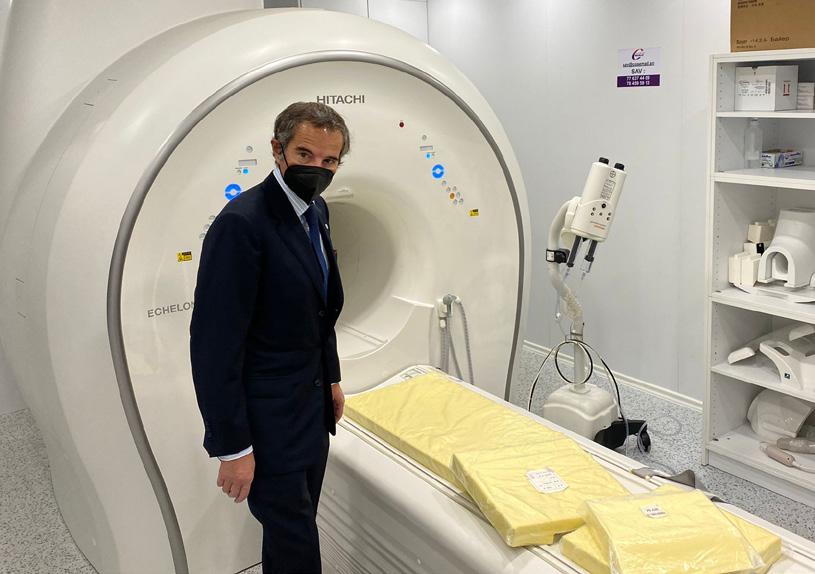
burden is unacceptable, and closing the cancer care gap in Africa must be prioritized.
For six decades, the IAEA has been a key player in the fight against cancer. We provide services supporting Member States in cancer treatment quality assurance and in improving national cancer control programmes. The IAEA is a nexus of knowledge for radiotherapy, nuclear medicine and diagnostic imaging, and globally helps facilitate training for cancer health workers. We convene cancer experts to accelerate innovation in cancer solutions and support countries in accessing equipment that is critical in the diagnosis and treatment of cancer.
But addressing the growing global cancer burden requires us and the international community to step up our efforts. By 2040, annual cancer cases in Africa are expected to double, with death rates exceeding the global average by almost a third.

Rays of Hope will strengthen national cancer control programmes and establish the first radiotherapy centres in countries without this life-saving technology and knowledge. Our initiative will help develop and expand infrastructure and capacity, and support innovation and the development of sustainable cancer solutions. Finally, Rays of Hope will strengthen international collaboration and enable developing countries to support one another through the establishment of regional ‘anchor centres’ of expertise.
Millions of people affected by cancer today live without any hope of treatment. Through Rays of Hope, we are determined to change that.
“Millions of people affected by cancer today live without any hope of treatment. Through Rays of Hope, we are determined to change that.”
— Rafael Mariano Grossi, Director General, IAEA
IAEA Bulletin, February 2022 | 1 Foreword
(Photos: IAEA)



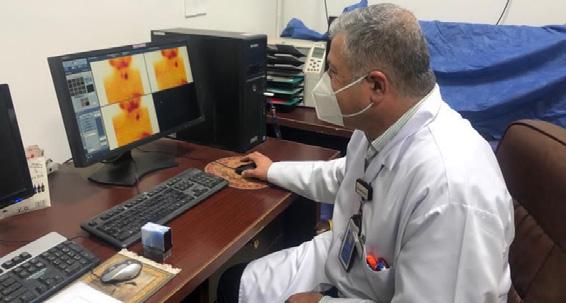

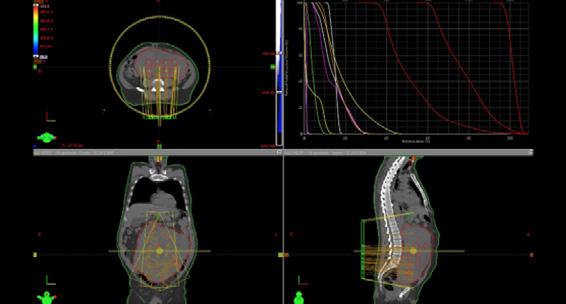
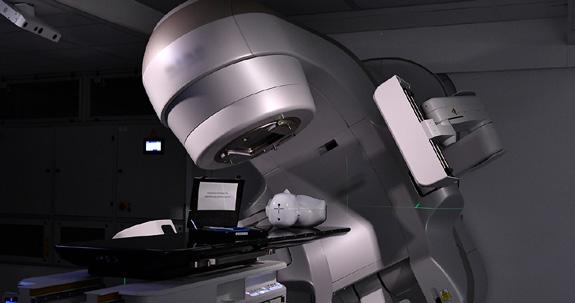
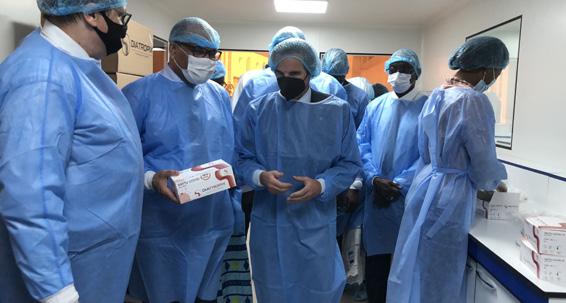
Contents 2 | IAEA Bulletin, February 2022 1 Ensuring cancer care for all 4 Rays of Hope New initiative to bring cancer care for all 8 A pathway of hope Guidance on setting up cancer centres 10 Unlocking the power of partnerships and innovative financing for improved access to cancer care 12 IAEA teams up for innovative and sustainable solutions for cancer care education 14 South–South cooperation Fostering sustainable solutions to fight cancer 16 Building radiopharmaceutical sustainability for cancer care in Africa 18 Radiation therapy on the wave of innovation
20 Digitalization in cancer control during the COVID-19 pandemic
22 The Niger’s first public radiotherapy centre opens
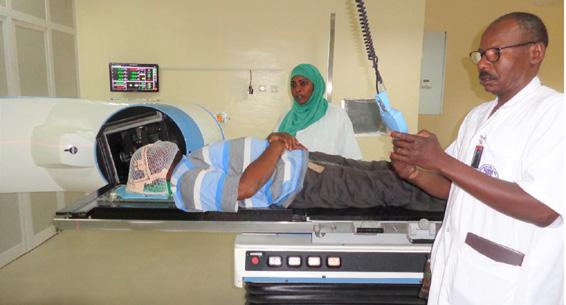

24 Accurately targeting women’s cancers in Mongolia

26 Uruguay takes decisive action to reverse high cancer incidence and mortality rates
28 Better screening and treatment to tackle cancer in Paraguay

29 Quality assurance
Dosimetry audits for safe and effective radiotherapy treatment
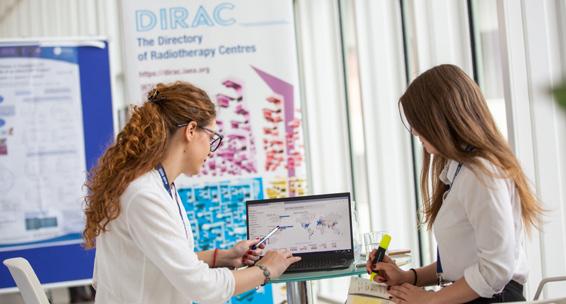
WORLD VIEW
30 The global agenda on cancer
— By Tedros Adhanom Ghebreyesus
32 Improving access to radiotherapy
Fighting cancer in partnership with the IAEA
— By the Ministry of Health and Social Action of Senegal IAEA
IAEA Bulletin, February 2022 | 3 Contents
UPDATES
33 IAEA News 36 Publications
Rays of Hope
New initiative to bring cancer care for all
By Lisa Berthelot
The global cancer situation
The chances of surviving cancer depend considerably on where you live in the world. For many people in low and middle income countries (LMICs), access to life-saving diagnostic and treatment services is still lacking — often stacking the odds against surviving a cancer diagnosis.
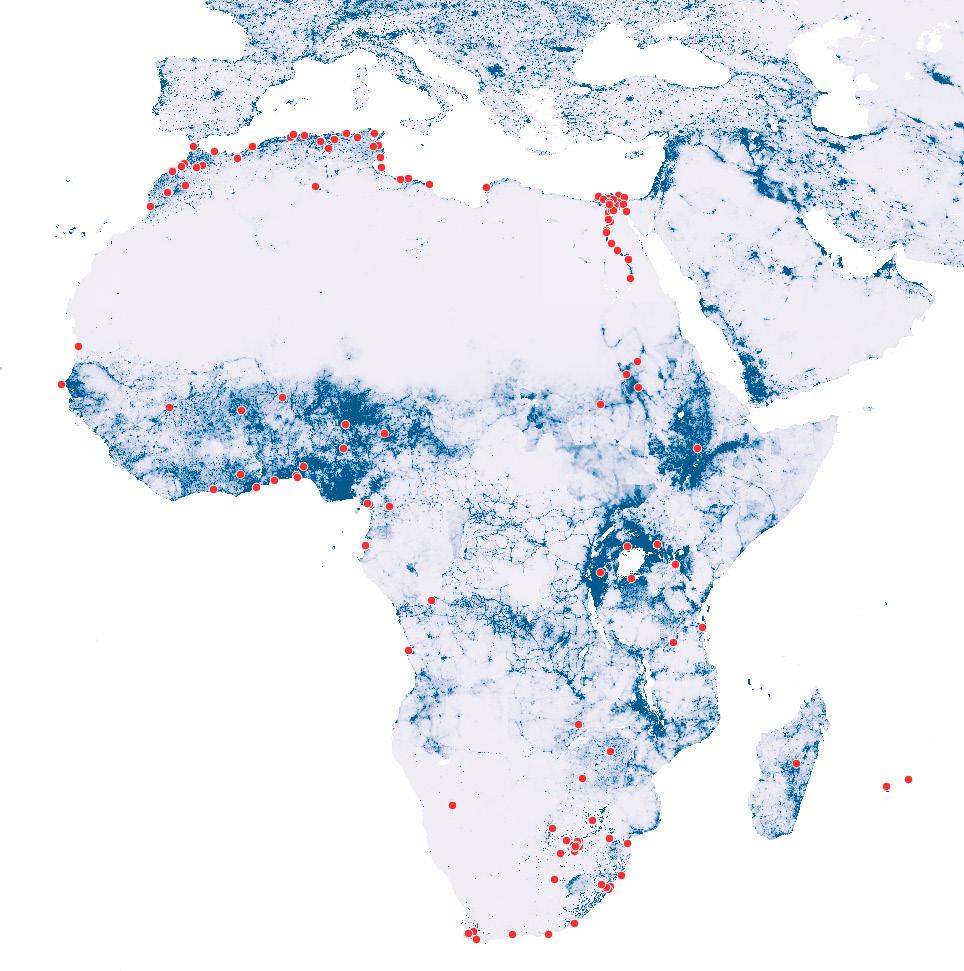
The lack of access to treatment is most acute in countries without facilities and personnel trained in radiotherapy. Radiation therapy is recognized as an essential tool in the cure and palliation of cancer, and is fundamental for treating over half of all cancer patients. Nevertheless, over 70 per cent of the population in Africa does not have access to radiotherapy, while other regions also have significant gaps in access. Only 5 per cent of global spending on cancer goes to LMICs and it is estimated that, by 2030, 70 per cent
of cancer deaths will occur in these countries. A new IAEA initiative, Rays of Hope, is setting out to change that and to help LMICs increase access to cancer care.
Over one third of all cancers can be prevented, and some of the most common forms — including cervical, breast, head and neck, and colorectal cancers — are curable if they are detected early and treated appropriately.
National cancer policies and programmes, when well conceived and implemented, will help reduce the cancer burden and improve services for cancer patients and their families, regardless of the country context.
A comprehensive approach to cancer control
Cancer control relies on evidence-based research to reduce the number of people who get cancer, experience cancer-related complications and die from the disease. This approach may be complex, costly and time-consuming, but, when implemented correctly, it can help countries to effectively reduce their cancer burdens and to increase the life expectancy of those diagnosed (see the infographic on page 7 for a breakdown of what comprehensive cancer control requires and how it is supported).
For over 60 years, the IAEA has supported countries in introducing nuclear techniques to diagnose and treat cancer. Through its technical cooperation programme, the IAEA provides long-term fellowships for training radiation medicine professionals, offers technical advisory services, procures equipment for diagnosis and treatment, supports radiation safety, conducts quality assurance, and publishes reports and guidance (see page 8 for guidance on setting up cancer centres). These efforts help respond to the increasing demand for safe, effective and sustainable radiology, nuclear medicine and radiotherapy services around the world.
Radiotherapy centre
Population distribution: Darker blue represents higher population density.
4 | IAEA Bulletin, February 2022 Cancer care for all
OVER 70% OF THE POPULATION OF AFRICA DOES NOT HAVE ACCESS TO RADIOTHERAPY.
Assistance to recipient countries is provided by working closely with international partners, such as the World Health Organization (WHO) and the International Agency for Research on Cancer (IARC). The IAEA also leverages capacities in each region by facilitating cooperation between countries and by using the capacities of technically advanced countries.
In 2022, the IAEA is seeking to further integrate its broad expertise to help the countries most in need of support in the diagnosis and treatment of cancer. This means bringing together technical and research project implementation, nuclear safety, resource mobilization, quality assurance services and missions, and the IAEA’s convening and coordination role.
A new form of hope
Hope — bolstered by commitment and competence — is the driving force, as the IAEA launches its new effort to support transformative cancer care in LMICs. The staggering cancer statistics, coupled with a robust international support capability, have
driven the IAEA to pioneer the Rays of Hope initiative, which is aimed at assisting LMICs with their urgent needs to introduce and improve radiation medicine capacities and to build the cancer care workforce.
Rays of Hope will support the sustainable, comprehensive introduction or expansion of radiotherapy, and will include support for regional ‘anchor centres’ and innovation.
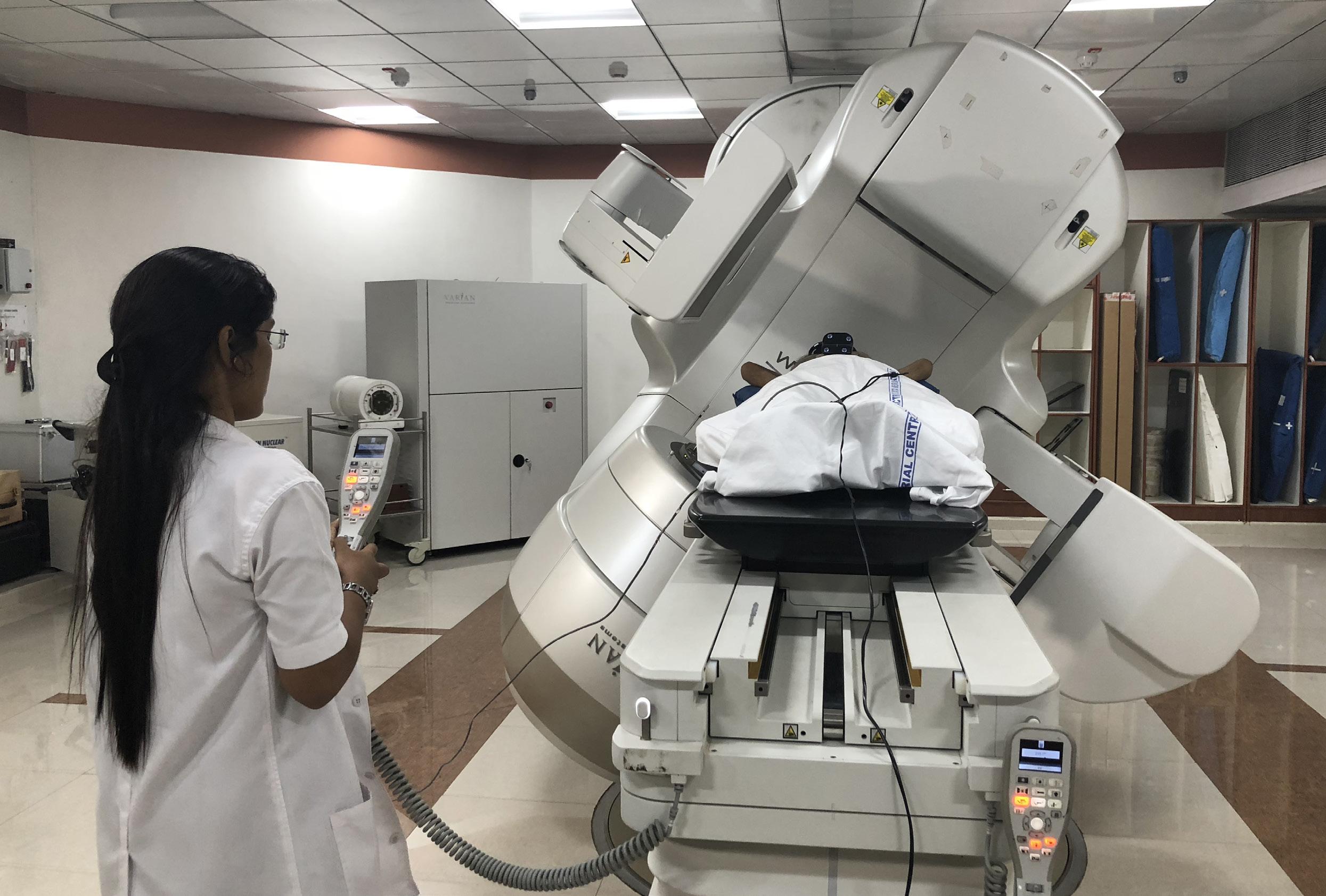
For countries with limited or no radiotherapy facilities, support will be made available to establish their first radiotherapy centres or to expand radiotherapy and diagnostic imaging capacities, in order to reach more of their populations. These decisions are made in close consultation with the relevant Member States, according to their identified needs.
The initiative will be composed of projects with a focus on sustainability, to support building or strengthening radiation safety legislation and infrastructure, and providing quality control, guidance, training and equipment. In order to start in a strong and targeted way, Rays of Hope will initially focus on prioritizing a limited number of
“With Rays of Hope, the IAEA will continue to support countries in enhancing their capabilities to better diagnose, stage and treat cancer, and will support global research, education and innovation.”
IAEA Bulletin, February 2022 | 5 Cancer care for all
— May Abdel-Wahab, Director, Division of Human Health, IAEA
high-impact, cost-effective and sustainable interventions in accordance with national capacities, needs and commitments.
“The IAEA has the knowledge, tools and expertise to help countries use nuclear techniques, such as radiotherapy, to tackle cancer and save lives,” said May AbdelWahab, Director of the IAEA’s Division of Human Health. “With Rays of Hope, the IAEA will continue to support countries in enhancing their capabilities to better diagnose, stage and treat cancer, and will support global research, education and innovation.”
The IAEA will also support innovation through coordinated research projects, as well as through educational infrastructure and support for anchor centres. These are centres that have provided experts and supported training in quality assurance, as well as the training of IAEA fellows, for decades.
The IAEA will continue to help countries to create technically sound bankable documents, which can be submitted to financial institutions to secure additional funding (see page 10). The IAEA will also facilitate partnerships with potential donors, including governments, international financial institutions and the private sector.
Rays of Hope has been developed to directly contribute to the fulfilment of the 2030 Agenda and Sustainable Development Goal 3 (SDG 3), which focuses on good health and well-being, and, in particular, SDG Target 3.4, on the reduction of premature mortality from non-communicable diseases.

Rays of Hope from all corners of the world
To successfully launch the initiative, ensure its sustainability and maximize its impact, the IAEA is mobilizing additional resources, advocacy and partnership opportunities. Funding is needed to build facilities, purchase equipment and train personnel. Also included are the necessary operating costs for two years per country, in order to better support sustainability. Various machines are required for the treatment of cancer, including
simulation units, cobalt machines and linear accelerators, and equipment to administer radioactive isotopes directly to cancerous tissue in the body. It is estimated that 50 per cent of cancer patients need radiotherapy treatments.
“Significant resources are needed to improve global equity in access to life-saving cancer treatment,” said Lisa Stevens, Director of the IAEA’s Division of Programme of Action for Cancer Therapy. “The goal of Rays of Hope is to bring together a global coalition of partners — including Member States, the private sector, development agencies and financial institutions — to support countries to establish radiotherapy centres and scale up existing capacities.”
The IAEA has prepared three different support packages depending on country needs. Each package comprises an optimal combination of machines, training and support from regional anchor centres. These centres will be designated to provide training and quality assurance to neighbouring countries. Innovation is an essential part of the package to ensure resources are used to scale up access to radiation medicine, including the participation of experts from recipient countries in online training events and professional discussions, and to increase the cost efficiency and effectiveness of interventions. The packages will also contribute to advancing development priorities, such as gender equality, reducing health inequities for women and children, and enhancing education and training, thereby fostering socio-economic inclusion.
Radiation safety and nuclear security infrastructure is required in order to protect patients, staff, the public and the environment. As part of the multifaceted initiative, the IAEA will also support the development and strengthening of safety and security infrastructure in countries that receive assistance from Rays of Hope.
Through Rays of Hope, the whole breadth of the IAEA’s expertise will be integrated to support countries in the diagnosis and treatment of cancer using radiation medicine — giving them a fighting chance.
“The goal of Rays of Hope is to bring together a global coalition of partners — including Member States, the private sector, development agencies and financial institutions — to support countries to establish radiotherapy centres and scale up existing capacities.”
6 | IAEA Bulletin, February 2022 Cancer care for all
— Lisa Stevens, Director, Division of Programme of Action for Cancer Therapy, IAEA
Improving Comprehensive Cancer Control and Care
To improve comprehensive cancer control, national ministries of health must consider cancer priorities and their health system capacities to deliver sustainable programmes.
Consideration of all areas of the cancer continuum
Requires an enabling environment
Legal and Policy Framework



Key Components of the Health System
e.g. the International Health Regulations and national law
e.g. nuclear safety and radiation protection
With committed Partners and Supporters e.g. development banks might provide access to loans or grants
Establishing
*Low Cancer care for all
countries
Training the workforce
Supporting regional anchor centres
Procuring equipment
Fostering innovation (research and education)
Regulatory
Health policy and legal framework
framework
Facilities
Information
Human resources Supplies
Equipment Money
!
e.g.
e.g. UICC and C/Can Non-governmental
International
WHO, IARC, UNDP, UNAIDS UNICEF, UNFPA, UN Women IAEA
Funding institutions
equipment manufacturers and pharmaceutical companies Private sector
organizations
organizations
DIAGNOSIS AND STAGING EARLY DIAGNOSIS PALLIATION PREVENTION TREATMENT SURVIVORSHIP SURVEILLANCE SCREENING
first radiotherapy centres in LMICs*
and middle income
IAEA’s Rays of Hope will support countries in: IAEA Bulletin, February 2022 | 7
Only 26 per cent of low income countries around the world have public sector pathology services for diagnosing cancer, and only 30 per cent of these countries have cancer treatment services.
A pathway of hope Guidance on setting up cancer centres
By Ramadan Faried Abbas Abdelaziz
In 2020, cancer killed nearly 10 million people, and new cancer cases are predicted to rise to between 29 and 37 million per year by 2040 unless dramatic action is taken, according to the International Agency for Research on Cancer. Addressing this challenge, and the tremendous burden cancer exerts physically, emotionally and financially on individuals, families, societies and health systems, will require building more cancer treatment facilities and rethinking the way the world tackles this disease.
A new joint publication, Setting up a Cancer Centre: A WHO–IAEA Framework, by the IAEA and the World Health Organization (WHO), will help by guiding policymakers, programme managers and clinical care providers in setting up and developing cancer treatment facilities in a phased manner. The guidance document supports the approach already established under the joint
IAEA–WHO publication Roadmap towards a National Cancer Control Programme: Milestones for establishing nuclear medicine, diagnostic imaging and radiotherapy services

“The world is facing an ever-growing cancer epidemic, and our cancer facilities are on the front line of this battle,” said May AbdelWahab, Director of the IAEA’s Division of Human Health. “The guidance document is a valuable tool in the planning and implementation of cancer centres, providing guidance on setting up different levels of cancer services within individual cancer centres. The ultimate goal is to improve the level of cancer services through a stepwise approach, providing context and requirements for specific services.”
This guidance is intended to cover multidisciplinary cancer care, and details
8 | IAEA Bulletin, February 2022 Cancer care for all
(Photo: IAEA)
the infrastructure, human resources and equipment needed for oncological and supportive care services, she said.
Facilities to tackle cancer
Cancer centres are facilities primarily for providing cancer care, but they are also essential for creating and implementing new treatment evidence through research and education, and provide guidance on all aspects of cancer within a country. While access to cancer centres varies widely around the world, such facilities are recognized as a critical part of the health care system when developing a cancer control strategy.
Cancer centres provide services relating to cancer prevention, diagnosis, multidisciplinary treatment, supportive care, research and education. The extent to which these services are provided depends on the local context, and they are constantly evolving to meet the demands of the cancer burden.
The capacity to prevent cancer and control the cancer burden is not equal between and within countries. In countries with underdeveloped health systems and limited resources, there is limited access to diagnosis and treatment. Furthermore, there are major deficits in the provision of cancer services, from prevention to survivorship care.
In 2019, for example, only 26 per cent of low income countries around the world reported having public sector pathology services for diagnosing cancer, and only 30 per cent of these countries had cancer treatment services. However, 90 per cent of high income countries could offer such services.
“The consequences of this insufficient capacity mean late diagnosis of cancer, suboptimal cancer care, poor outcomes and high out-of-pocket expenditure,” said Cherian Varghese, coordinator for non-communicable diseases and special initiatives at the WHO. “Other consequences include the failure to achieve global targets, including reduction in premature mortality from non-communicable diseases, as outlined in the Global Action Plan for the Prevention and Control of Noncommunicable Diseases.”
A comprehensive guide
The guidance document shows how an increase in capacity at cancer centres should be framed within a broader national context of comprehensive cancer control planning and be cognizant of the potential exacerbation of inequalities associated with higher costs and centralized services. Introducing readers to background information on cancer centres, the document presents an example of a care pathway for a patient with cervical cancer to demonstrate the typical flow of the patient experience through a cancer centre.
The document explores the essential elements of cancer centres, with discussion on establishing such centres; patient care pathways; infrastructure and facility requirements in relation to diagnosis, staging, multidisciplinary and multimodality treatment, and palliative and supportive care; preventive oncology and oncology nursing; information systems, medical records and registry; education, training and research; and governance, administration, financing, advocacy, community engagement and partnerships.

IAEA Bulletin, February 2022 | 9 Cancer care for all
Unlocking the power of partnerships and innovative financing for improved access to cancer care
By Luka Vukadinovic
Uzbekistan has been battling a growing cancer burden for years. The disease killed more than 20 000 people in 2020 and this number is expected to almost double by 2040, according to the International Agency for Research on Cancer’s Global Cancer Observatory. However, this may soon change thanks to support from the IAEA and its partners.
Within the framework of the partnership agreement between the IAEA and the Islamic Development Bank (IsDB), the IAEA provided support to the Government of Uzbekistan with the elaboration of a bankable document — a detailed feasibility study that was used to successfully secure US $80 million in concessional financing from the IsDB. The money will support the Government’s efforts to enhance access to and quality of oncology services throughout the country.
Over the past decade, the international community has rallied behind policies to address the growing cancer burden, for example through the adoption of a resolution on cancer prevention and control approved at the 2017 World Health Assembly, the Global strategy to accelerate the elimination of cervical cancer as a public health problem and the Global Initiative for Childhood Cancer. However, these strategies have not yet received the implementation funding initially hoped to successfully fight the growing burden of non-communicable diseases.
Globally, all non-communicable diseases combined, including cancer, accounted for just two per cent of development assistance allocated to health between 2000 and 2018, according to the Institute for Health Metrics and Evaluation at the University of Washington. This means that cancer is receiving a negligible share of financing, which is often directed towards prevention and screening programmes because of their cost-effectiveness. As a result, diagnosis
and treatment remain grossly underfunded, and, today, 23 countries still completely lack radiation treatment facilities. The COVID-19 pandemic has further exacerbated this problem, as donors are channelling their efforts and resources to pandemic response, while the pandemic has also adversely impacted other health services, including cancer care, worldwide.
“This is why international financial institutions, such as the IsDB, are a major source of funding for developing countries, and their support has never been more critical,” said Cindy Kremer, Head of the Resource Mobilization Section at the IAEA’s Programme of Action for Cancer Therapy. “This is particularly true when it comes to cancer care and the provision of essential equipment and infrastructure, such as bunkers that house radiation therapy machinery.”
Kremer said substantial financing for such investments is rarely provided through grants, so the IAEA is closely collaborating with the IsDB on funding developing countries through a multi-stakeholder blended financing structure involving the private sector.
However, the work does not stop there. To address the growing need for funds and maximize the impact of the new Rays of Hope initiative (see page 4), the IAEA is taking steps to develop similar collaboration modalities with other financial institutions, as well as to expand existing and establish new partnerships with the private sector and philanthropic organizations, Kremer said.
Leveraging private sector finance and expertise
The private sector is a strategic development partner for the IAEA, offering expertise as well as innovative tools, technologies and resources that are crucial for reinforcing the organization’s impact on the ground, Kremer explained. Over the past several years, the
“[...] international financial institutions, such as the IsDB, are a major source of funding for developing countries, and their support has never been more critical. This is particularly true when it comes to cancer care and the provision of essential equipment and infrastructure, such as bunkers that house radiation therapy machinery.”
10 | IAEA Bulletin, February 2022 Cancer care for all
— Cindy Kremer, Head, Resource Mobilization Section, Programme of Action for Cancer Therapy, IAEA
IAEA has partnered with companies leading the development and delivery of cancer care solutions.
An example of this is a long-standing collaboration with Varian Medical Systems to help hospitals around the world deliver more precise radiotherapy doses and train health care workers. The equipment provided through this partnership helped the IAEA expand its dosimetry services to include electron beam audits. These audits, which now serve more than 300 hospitals each year, help ensure that the doses used to treat patients are high enough to be effective but not too high to cause undue harm.
Quality assurance programmes of this kind help ensure that cancer patients receive safe and effective radiotherapy treatment. Lora Ioannou and Stefani Stefanou, Radiotherapy Medical Physicists from the Bank of Cyprus Oncology Centre in Nicosia, have relied on the IAEA for dosimetry audits of the photon beams in their hospital for many years. “We welcome the inclusion of electron beam audits because we will be able to confirm the accuracy of the doses we deliver to our patients that are treated with electron beams,” Ioannou said.
Similarly, the IAEA has recently partnered with the Global Access to Cancer Care Foundation (GACCF), a leading cancer care organization with an expansive network of partners in industry and academia that provides oncology education programmes in low and middle income countries. The strategic alliance is enhancing training for cancer care professionals in nuclear medicine and radiation therapy through on-location teaching courses and allows the IAEA to leverage the expertise of the private sector to deliver cutting-edge care to a large number of patients across the developing world.
“GACCF is on the front lines, providing life-saving cancer treatment education for medical specialists and creating access to radiotherapy treatments throughout the developing world. Together with the IAEA, we are able to provide cancer care professionals with the education and tools they need to save lives,” said Tonya Steiner, Executive Director and Chief Executive Officer of GACCF. The partnership, however, goes beyond capacity building to include outreach activities and awareness-raising programmes through relevant regional/global initiatives and high-level events with key partners and stakeholders.
An oncology resident uses a donated CT simulator to analyse the scan of a patient at Ethiopia’s Black Lion Hospital.
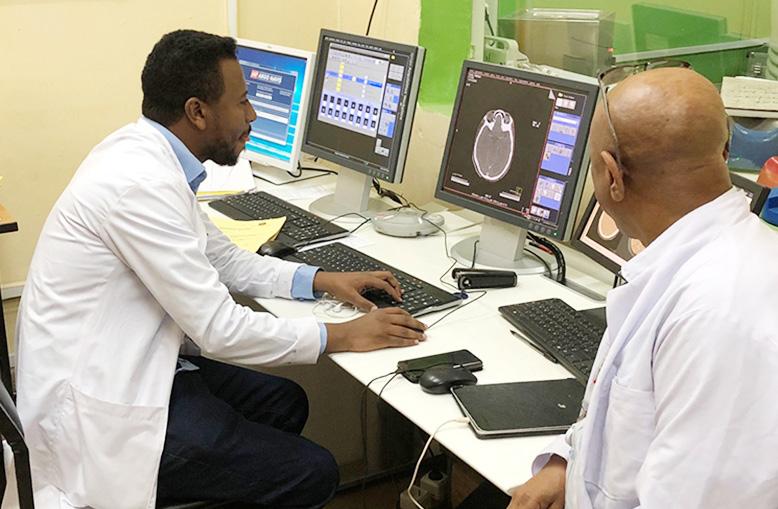
IAEA Bulletin, February 2022 | 11 Cancer care for all
(Photo: M. Gaspar/IAEA)
IAEA teams up for innovative and sustainable solutions for cancer care education
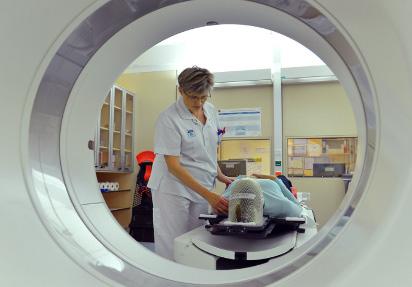 By Lenka Dojcanova
By Lenka Dojcanova
For medical physicists Daniel Venencia and Bertha García Gutiérrez, 2021 was a busy year. Venencia, in his role as remote mentor, advised Gutiérrez, of Peru’s Auna Oncosalud clinic, on performing measurements for her PhD thesis in dosimetry for radiosurgery, a technique for destroying cancer cells using high doses of radiation. Once awarded, Gutiérrez will become one of the few medical physicists in Peru with a PhD. Medical physicists are health professionals working in cancer treatment who are responsible for determining the exact radiation dose to target cancer cells with minimal damage to healthy tissue.
Venencia, who is based in Argentina, was paired with Gutiérrez thanks to an IAEA
doctoral coordinated research project (CRP). The goal of CRPs and other IAEA educational initiatives is to create innovative and sustainable partnerships with research institutions. But what is the benefit of such partnerships?
“The current global educational and training capacities still struggle to train a sufficient number of professionals to meet the great need for radiation oncology and radiation medicine professionals,” said May AbdelWahab, Director of the IAEA’s Division of Human Health. “Partnerships in education are essential as we continue to provide support to Member States and fill the gaps, including through the IAEA research programme’s doctoral CRP mechanism.”
External beam simulation set up for treating cancers of the head and neck.
12 | IAEA Bulletin, February 2022 Cancer care for all
(Photo: D. Calma/IAEA)
By joining forces in education for cancer diagnosis and treatment with almost 30 global and national partners, the IAEA facilitates the development and sharing of the latest knowledge, data, technology, skills and research in these specialized areas.
Building and sharing knowledge to combat global inequality
Collaborating with research institutions globally, the IAEA is helping specialists from regions with fewer training opportunities to obtain appropriate qualifications. One such example is a recently launched series of webinars organized by the IAEA and Ireland’s Trinity College Dublin, an institution with experience in building train the trainers programmes for radiation therapists (RTTs), who are responsible for preparing patients for radiotherapy treatment. Trinity College Dublin is also helping the IAEA to conduct a survey in a number of countries, assessing the barriers to implementing the curriculum for RTTs.
“At Trinity College Dublin, we are committed to providing the highest quality education to all health professionals working in the field of radiation oncology,” said Michelle Leech, Associate Professor in Radiation Therapy at the university. “We look forward to adding the Trinity expertise to that of the IAEA in tackling this global inequality and ultimately improving patient care.”
Another example is the ongoing partnership with the St. Jude Children’s Research Hospital in the United States of America, which is specialized in paediatric treatment of diseases such as cancer. Under a 2019 agreement, experts from the hospital participated in IAEA training for radiotherapy professionals, and provided insights into the latest research in paediatric radiation oncology during the 2021 International Conference on Advances in Radiation Oncology (ICARO-3). Similarly, Boston Children’s Hospital, also in the United States of America, is working with the IAEA on a new research project to increase survival rates in children with cancer through improving nutritional support. Low and middle income countries, where a child is four times more likely to die of cancer than in a high income
country, are especially able to benefit from these partnerships.
In addition to these efforts, the IAEA regularly enables health professionals to benefit from scientific conferences and meetings organized by partner organizations and institutions. In 2021 alone, the IAEA supported 5000 nuclear medicine and radiology professionals attending conferences such as the European Congress of Radiology.
The IAEA is also teaming up with external experts to identify and implement innovative solutions to help professionals gain and maintain the latest qualifications and skills. “We must encourage innovation in our educational tools; we aim to increase efficiency and effectiveness to fill the gap in the sector,” said May Abdel-Wahab.
One such example is the Comprehensive e-Learning Platform (CeLP), a set of diseasespecific e-learning tools and modules that include micro-learning, multimedia and virtual reality, which involves collaboration with professional groups. Another result of a collaborative initiative is the TNM Cancer Staging App — a mobile app developed in cooperation with India’s Tata Memorial Centre and the All India Institute of Medical Sciences (AIIMS). The app gives doctors easy access to information, equal to a 1000page book, on determining the level of treatment and prognosis for cancer patients, such as the extent of a tumour and lymph node spread.
In the area of radiology and nuclear medicine, in 2018 the IAEA and 26 other leading societies and organizations launched the first ever effort to assess the need for imaging and nuclear medicine resources worldwide; the Lancet Oncology Commission on Medical Imaging and Nuclear Medicine found dramatic inequalities in access to imaging resources and has outlined a compelling health economics case for countries based on data from the IAEA Medical Imaging and Nuclear Medicine Global Resources Database (IMAGINE) (see page 21). Through their accessibility, these and other collaborative initiatives support much needed innovative and sustainable knowledge and skills delivered to health professionals to all countries.
“We must encourage innovation in our educational tools; we aim to increase efficiency and effectiveness to fill the gap in the sector.”
IAEA Bulletin, February 2022 | 13 Cancer care for all
— May Abdel-Wahab, Director, Division of Human Health, IAEA
In November 2021, the IAEA, in cooperation with the World Health Organization and the International Agency for Research on Cancer, completed a virtual imPACT Review to support Iraq.

South–South cooperation Fostering sustainable solutions to fight cancer
By Joanne Liou
When the IAEA began helping Zambia to formulate its national cancer control programme (NCCP) last year, radiation oncologist Kennedy Lishimpi joined experts from Egypt and South Africa, countries with advanced cancer control plans in place, to help draft his own country’s plan. Lishimpi, who serves as the Director and National Coordinator of Cancer Control Services in Zambia, is now paying it forward and leading a team of experts to help Sierra Leone with its own NCCP.
“The Zambian NCCP aims to reduce cancer incidence and is specific to the cancer burden of our country. The IAEA’s support has helped to shape the nation’s programme to build capacity for and transform cancer control in Zambia,” Lishimpi said. “Now we are able to contribute to Lesotho’s and Sierra Leone’s efforts and share our lessons learned.”
Global partnerships, including through South–South and triangular cooperation, is essential in fighting cancer and providing adequate treatment with sustainable solutions. South–South cooperation is the mutual exchange of knowledge and resources between and among countries in the Global South to meet development goals, while fostering self-reliance and ownership of activities. Triangular cooperation involves third parties, such as donor countries and organizations, that help facilitate South–South initiatives through funding and training.
“The IAEA facilitates the first interactions among countries that often develop into lasting institutional partnerships. These partnerships enable South–South cooperation to last beyond a specific point in time,” said Geraldine Arias de Goebl, Head of the Cancer Control Review and Planning Section at the IAEA. “With the support of the IAEA, many
14 | IAEA Bulletin, February 2022 Cancer care for all
(Photo: M. Khadim Alaboodi/Al-Amal National Hospital for Oncology, Iraq)
countries have established and continue to strengthen national policies and regional capacities in cancer control.”
The IAEA’s Programme of Action for Cancer Therapy (PACT), which was established in 2004, supports three areas in cancer control: assessment, planning and resource mobilization. The IAEA is currently supporting more than 20 countries in their comprehensive cancer control assessments and planning, and more than 100 countries are benefiting from cancer-related technical cooperation projects.
“In collaboration with the World Health Organization (WHO) and the International Agency for Research on Cancer (IARC), we identify local experts to assess the cancer control situation to help with planning. Typically, two to three experts from the same region with more advanced plans support the in-country experts,” Arias de Goebl said. Later on, as their own capacities are strengthened, those experts serve their peers in the region by sharing their experiences and knowledge with other countries. For example, experts from Cuba and Spain are supporting Paraguay with its NCCP, while, in Central Asia, the cancer team in Uzbekistan is benefiting from collaboration with Kazakhstan and the Russian Federation, among others.
In April and October 2021, the IAEA convened international experts who are helping countries to develop NCCPs to share good practices and challenges, including with regard to advancing NCCP advisory support virtually. “These workshops are part of a larger effort by the IAEA, through PACT, to strengthen South–South cooperation on cancer control, to create a knowledge sharing community within and across regions, and to expand the base of expertise available to support low and middle income countries in cancer control planning and governance,” said Arsen Juric, a PACT Programme Officer.
Assessment and action
To assess a country’s cancer control capacities, the IAEA conducts imPACT Reviews with experts from the region, in order to provide a baseline situation analysis and recommendations to guide cancer control planning and investments (see page 27).
In November 2021, the IAEA, the WHO and the IARC completed a virtual imPACT Review to support Iraq. In cooperation with the Iraqi Ministry of Health, an international team of experts, including experts from Jordan and Turkey, assessed Iraq’s cancer control capacities and needs, from registration and surveillance to diagnosis, treatment and palliative care. “During the review process, we identified capacity needs and the Iraqi medical specialists who would benefit from specific education and training,” said Juric, the coordinator of Iraq’s imPACT Review. “As a result of the Review, scientific visits were arranged to Jordan and Turkey for Iraqi cancer specialists to observe the design and service delivery of oncology facilities, with regard to radiotherapy, radiology, medical physics and related safety dimensions.”
Regional platforms for cooperation
Under the auspices of the IAEA, four regional cooperative agreements — covering Africa, Asia and the Pacific, Latin America and the Caribbean, and the Middle East — bring together countries to identify priorities and collectively agree on projects to implement. As a result, these regions have strengthened cancer treatment and improved patient care and capacities through educational programmes.
In Africa, for example, Morocco is leading the fight against cervical cancer, which kills 300 000 women each year globally, of whom 90 per cent are in developing countries. “Out of the top 20 countries with cervical cancer incidences, 19 are in Africa, and 268 million women aged 15 and above are at risk of developing cervical cancer,” said Azzeddine Farhane, Ambassador of Morocco to Austria and Permanent Representative to the United Nations and other international organisations in Vienna, including the IAEA.
Taking a triangular cooperation approach to cervical cancer, Morocco has been working with the IAEA and other African countries. The IAEA has supported the North African country in organizing training workshops and courses for hundreds of Moroccan and other African participants to collectively address the cancer burden, as well as COVID-19. Furthermore, 43 Moroccan experts have been sent by the IAEA to other African countries for training.
“The IAEA facilitates the first interactions among countries that often develop into lasting institutional partnerships. These partnerships enable South–South cooperation to last beyond a specific point in time.”
IAEA Bulletin, February 2022 | 15 Cancer care for all
— Geraldine Arias de Goebl, Head of the Cancer Control Review and Planning Section at the IAEA.
Practical training sessions on the use of radiopharmaceuticals with African experts took place in Indonesia.
Building radiopharmaceutical sustainability for cancer care in Africa
By Puja Daya
Cancer is a leading cause of death globally, but it is one that hits lower income countries particularly hard. Without the use of radiopharmaceuticals — medical drugs containing radioisotopes — the abilities of doctors in such countries to detect and treat cancer are limited.
This problem is especially acute in Africa. In order to address it, the IAEA is helping African countries to build expertise through educational and training programmes, and to develop their own facilities to locally produce radiopharmaceuticals, which in many cases have a short shelf life and need to be used quickly after production.
Local and independent radiopharmaceutical production will lessen African countries’ reliance on imported shipments and expertise and help to reduce costs. Trained and qualified radiopharmacists are key to this strategy.
“Without qualified radiopharmacists, the sustainable use of radiopharmaceuticals for cancer care is nearly impossible,” said Aruna Korde, a radiopharmaceutical scientist at the IAEA. She has been working with health and education authorities in Africa to develop training for local radiopharmacists. “Countries require their
own radiopharmacists to contribute to the diagnosis of cancer patients as soon as possible, and we are helping make that happen by expanding radiopharmacist training into different languages,” Korde said.
Through an IAEA technical cooperation project, in collaboration with the Government of Morocco, a French-language master’s programme on radiopharmacy was introduced to address Africa’s shortage of qualified radiopharmacists. In 2021, the first cohort from the programme graduated, giving Burkina Faso, Côte d’Ivoire, the Democratic Republic of the Congo and Mauritius their own certified radiopharmacists for the first time. A similar collaboration with South Africa led to radiopharmacists from Ethiopia, Kenya, Uganda and Zambia completing their master’s programmes. Furthermore, radiopharmacists continue to be trained in Africa through hands-on training courses.
To enhance the knowledge of radiopharmaceuticals in the region, the IAEA is helping to establish the African Association of Radiopharmacy, to be launched in February 2022. The Association will bring together a network of radiopharmacy professionals to collaborate and share experiences. As part of this initiative, the

16 | IAEA Bulletin, February 2022 Cancer care for all
(Photo: Indonesia’s National Nuclear Energy Agency (BATAN))
IAEA is supporting both the development of a regional education centre to train radiopharmacists and the upgrading of facilities to strengthen the self-sufficient production of radiopharmaceuticals.
Expanding and upgrading radiopharmacy facilities
As the field of radiopharmaceuticals rapidly evolves and more advanced diagnostic techniques, such as positron emission tomography (PET) and radiotherapeutics, become increasingly common, countries new to radiopharmaceuticals need to catch up quickly, explained Korde.
Several African countries are working on expanding and upgrading their radiopharmaceutical facilities for the production of radiopharmaceuticals, with the help of the IAEA’s technical cooperation programme and through IAEA coordinated research projects.
Through support from the IAEA, Tunisia has been able to start using PET, while Algeria recently installed and started a medical cyclotron — a machine that enables the country to produce its own radiopharmaceuticals and allows for routine PET imaging for many types of cancers, such as lymphomas and lung and colon cancers.
THE SCIENCE
This has also enabled the implementation of labelling with the radioisotope gallium-68, which is used for the diagnosis and staging of prostate cancer and neuroendocrine tumours. PET imaging will also allow for the introduction of effective and targeted cancer treatment therapy.
Nuclear medicine and PET imaging techniques are essential for cancer management but are increasingly expensive and inaccessible in many countries. With the new cyclotron facility in Algeria, it is now possible to easily produce large quantities of radiopharmaceuticals to help diagnose and treat more patients each day.
“The development and use of radiopharmaceuticals and their applications in recent years has allowed us to increase our knowledge in detecting, assessing and better treating various types of cancers we previously could not,” said Salah Bouyoucef, Professor of Nuclear Medicine at the Bab El Oued Teaching Hospital in Algeria.
Through IAEA initiatives, African countries that previously had no capacity to produce and use radiopharmaceuticals now do, or soon will. Ethiopia, for example, is in the midst of building its first medical cyclotron at St. Paul’s Hospital Millennium Medical College in Addis Ababa.
How radiopharmaceuticals work and fight cancer
Radiopharmacy involves the preparation and handling of radiopharmaceuticals for diagnosis, treatment and palliation, and is increasingly used for the management of cancer. It enables the screening of tumours, the selection of appropriate therapies, and the monitoring and evaluation of a tumour’s behaviour. Radiopharmaceuticals are produced in hospitals or at industrial radiopharmacies by radiopharmacists, who are responsible for ensuring product quality and radiation safety.
Radiopharmaceuticals contain small amounts of radioactive substances called radioisotopes — atoms that emit radiation. The radioisotopes used can be produced by irradiating a specific target inside a nuclear research reactor or in particle accelerators, such as cyclotrons. Once produced, the radioisotopes are tagged on to certain molecules based on biological characteristics, which result in radiopharmaceuticals.
Once inside a patient’s body, the different physical characteristics and biological properties of radiopharmaceuticals cause them to interact with or bind to different proteins or receptors. The drugs tend to concentrate more in specific body parts depending on the physiological processes and biological characteristics of the radiopharmaceutical. Using special cameras, doctors are able to precisely examine cancerous cells by selecting specific types of radiopharmaceuticals that bind with tumours and make them distinctive. If the radioisotope emits particulate radiation, the radiopharmaceutical may also be used in therapeutical applications.
IAEA Bulletin, February 2022 | 17 Cancer care for all
This figure illustrates a large abdominal-pelvic metastatic tumour being irradiated using SFRT. The red ‘bubbles’ represent high radiation doses which directly kill the tumour cells. The areas around the red bubbles in the wider red circle are impacted by lower doses, which provoke an immunological response that further destroys the tumour.
Radiation therapy on the wave of innovation
By Eleonora Colzani
Cancer has always been a concern for humanity. The disease is evident in fossils and mummies, present in historical writings, and can be passed down from our ancestors. In fact, the oldest recorded cases of cancer date back over 3500 years to ancient Egypt, and a malignant tumour has been found on a toe bone of a human fossil that is 1.7 million years old. Today, scientists are developing new forms of cancer treatment such as radiation therapy, also known as radiotherapy, to combat this disease.
Radiotherapy involves delivering ionizing radiation from beam generators or radioactive sources to target and destroy cancer cells. In order to reduce the risk of damaging the healthy surrounding tissue, new techniques are being developed to improve the precision of radiotherapy.
Riding on the 21st century’s wave of technological innovation, tools and techniques such as stereotactic body radiation therapy, spatially fractionated radiation therapy and artificial intelligence are making treatments more effective and efficient with less side effects.
Stereotactic body radiation therapy

Stereotactic body radiation therapy (SBRT) is an emerging advanced treatment technique that targets tumours with high precision and very high doses of radiation. This delivery method limits the impact on the healthy surrounding tissue, which reduces the likelihood of side effects. As such, it offers a potentially curative therapy or a valuable alternative therapy for many tumour types, including cases in the lungs, liver, brain and pancreas.
The IAEA is helping to implement this treatment technique in several countries through coordinated research projects (CRPs) and technical cooperation projects. One such project is devoted to investigating SBRT’s effectiveness in cases of non-operable hepatocellular carcinoma — the most common type of liver cancer and the sixth most common cancer type.
“We expect the results of this project will have an impact on current treatment standards and will be particularly relevant for developing countries,” said Lisbeth Cordero, a radiation oncologist at the IAEA involved in the SBRT projects.
18 | IAEA Bulletin, February 2022 Cancer care for all
(Image: Naipy Perez/Innovative Cancer Institute, USA)
Spatially fractionated radiation therapy
Spatially fractionated radiation therapy (SFRT) is a radiotherapy technique that allows for the delivery of relatively high, but varying, doses of radiation across a large tumour, while protecting the healthy surrounding organs. One SFRT technique, grid radiotherapy, uses a physical block with small holes that allows a tumour to receive a combination of high and low doses of radiation. Another technique, lattice radiotherapy, achieves a similar effect using a computer model.
“Research suggests an excellent response rate when SFRT is applied to large tumours,” said Cordero. “While SFRT has been used for some time, technological advances now allow for much safer application of such radiotherapy techniques.”

In April 2020, the IAEA initiated a CRP on the efficacy of SFRT in the palliative treatment of lung and cervical cancers. The project is investigating the use of SFRT in improving patients’ response to palliative radiotherapy — a treatment that relieves the patients’ symptoms and delays the progression of the disease.
Artificial Intelligence in radiation therapy
Another significant example of how radiation therapy is becoming increasingly innovative is in the application of artificial intelligence
improve the efficiency, accuracy and quality assurance of radiation therapy. Such tools can be applied at all stages of a patient’s treatment, from diagnosis to treatment and follow-up, bringing about unprecedented improvements in automatization.
“In health care, AI is already making its entrance in a variety of subfields, including disease detection. That includes both medical imaging as well as digital pathology, and the optimization of health care services logistics and cancer treatments,” said Jan Seuntjens, Head of Medical Physics at the Princess Margaret Cancer Centre in Canada.
The path to the clinical implementation of AI tools is not clear of obstacles, said Kamal Akbarov, a radiation oncologist at the IAEA. He explained that several challenges still lie ahead, leaving many AI tools at a proof-ofconcept stage and far from clinical adoption. Nonetheless, current studies and the increased interest of commercial vendors show the potential of AI tools in radiation therapy. The IAEA held a meeting of experts in October 2021 to discuss AI-based approaches in nuclear technologies, including radiotherapy.
Furthermore, a joint project between the IAEA and the European Society for Radiotherapy and Oncology (ESTRO) on radiotherapy contouring skills in AI-enabled clinical environments is planned to start in 2022. The project will consider whether AI can help redistribute the workload from the health workforce by enabling quicker
Training with the latest tools helps radiation oncologists deliver precise cancer treatments while minimizing harm to healthy tissue.
IAEA Bulletin, February 2022 | 19 Cancer care for all
(Photo: D. Calma/IAEA)
Digitalization in cancer control during the COVID-19 pandemic
By Michael Amdi Madsen
The COVID-19 pandemic has dramatically affected the provision of cancer services, both screening and treatment; however, it has opened the door for increased digitalization. With the challenges of COVID-19 came the need for hospitals to redirect resources, time and bed space to coronavirus patients, at the expense of other treatments, including for cancer. Statistics from Public Health Scotland in the United Kingdom, for example, show that, owing to COVID-19-related restrictions, breast cancer diagnosis fell by 19 per cent, bowel cancer by 25 per cent and lung cancer by 9 per cent during the first nine months of the pandemic, compared to 2018 and 2019. This is worrying because a delay in the diagnosis of cancer is associated with a worse outcome.
The COVID-19 pandemic has led to compromises in comprehensive cancer control programmes. However, it has also led to a faster uptake of digital technologies and virtual knowledge sharing— with beneficial results that are expected to outlast the pandemic.

To support cancer centres, and ultimately patients, the IAEA has advanced the digitalization of its cancer and human health programmes. The Human Health Campus is
an online educational and resource website which helps health professionals in nuclear medicine, radiology and radiotherapy, and nutrition access the latest and most accurate information for dealing with service changes brought on by COVID-19.
“The acceleration of digitalizing resources during the early phase of the pandemic, through platforms like the Human Health Campus, means we are reaching more people than ever before,” said Katherine Wakeham, Head of the IAEA’s Applied Radiation Biology and Radiotherapy Section. “Online, we are helping to enhance the capabilities of health professionals looking to learn about cancer treatment. While this medium is not new, there is growing acceptance, and eagerness from people to learn online has been accelerated.”
By enhancing virtual learning and support through collaborative initiatives with medical experts, the IAEA is facilitating and streamlining access to educational resources. The IAEA’s Comprehensive e-Learning Platform (CeLP), for example, is an integrated set of disease-specific e-learning tools and modules that include microlearning, multimedia and virtual reality.
“We have thousands of institutions worldwide delivering cancer care very successfully in the pandemic. One of the things that COVID-19 has done is that it has, in fact, accelerated the adoption of telehealth.”
— Dow Wilson, Chief Executive Officer at Varian Medical Systems.
20 | IAEA Bulletin, February 2022 Cancer care for all
(Photo: IAEA)
Online platforms, such as the Asia-Pacific Radiation Oncology Network (ASPRONET) and Africa Radiation Oncology Network (AFRONET), have been strengthened, and are used to share information and connect peer support radiation oncology departments regionally.
Telehealth and virtual conferences
Beyond e-learning and networking, the past two years have also seen a faster uptake of innovative technology and techniques. The use of telemedicine for consulting patients, for tumour board meetings and for treatment planning has greatly expanded, and cloudbased and remote systems now allow effective care to be delivered with fewer on-site personnel requirements and reduced on-site space requirements.
“This whole realm of telehealth is very important,” said Dow Wilson, Chief Executive Officer at Varian Medical Systems. “We have thousands of institutions worldwide delivering cancer care very successfully
DIRAC and IMAGINE
in the pandemic. One of the things that COVID-19 has done is that it has, in fact, accelerated the adoption of telehealth.”
The IAEA has transitioned to hosting many of its conferences online, enabling wider access to its information. The International Conference on Molecular Imaging and Clinical PET–CT in the Era of Theranostics (IPET-2020), held in November 2020, and the International Conference on Advances in Radiation Oncology (ICARO-3), held in February 2021, each attracted over 3000 attendees.
“IPET-2020 and ICARO-3 are great examples of how, by adapting to the conditions imposed by the COVID-19 pandemic, we can improve cancer care knowledge sharing,” said Wakeham. “While there are definite advantages in having a physical conference for fostering interpersonal connections and in-depth discussions, we have found that virtual conferences can be far more inclusive and attract more attendees from all income backgrounds.”
The Directory of Radiotherapy Centres (DIRAC) is a comprehensive online database of radiotherapy resources. It contains current and historical global data, going as far back as 1959, on radiotherapy centres, teletherapy machines, brachytherapy units, treatment planning systems, and computed tomography systems and simulators.
Continuously updated with voluntarily provided information from organizations, radiotherapy centres and other institutions from over 150 countries, DIRAC data is systematically reviewed by a team of experts at the IAEA and verified to detect inconsistencies and ensure completeness. A powerful tool, DIRAC can be used to assess existing radiotherapy infrastructure, plan new radiation oncology centres, and extract performance and quality indicators related to radiotherapy services. Such analyses are used to advocate for equity in the access to cancer treatment, invest in health care infrastructure, benchmark radiotherapy resources, and support academic research.
DIRAC is also a collaborative tool, providing data analysis information and interactive maps, and its users can view and upload information on individual radiotherapy centres and data summaries for countries, regions and even the entire world. Over the past decade, DIRAC has become an essential tool for global health studies and, as a result, more than 180 papers referring to DIRAC data have been published in peerreviewed journals since 2011.
The IAEA Medical Imaging and Nuclear Medicine Global Resources Database (IMAGINE) is a comprehensive compilation of medical imaging and nuclear medicine resources. With information on infrastructure from over 170 countries and territories, IMAGINE showcases findings in world maps and charts, and can show the degree to which imaging, nuclear medicine technologies and relevant skilled human resources are inequitably distributed around the world.
The IAEA is committed to scientific cooperation and to the transfer of nuclear technologies to countries, and IMAGINE helps provide accurate information on the status of technology, facilities, workforce and educational infrastructure to address countries’ needs.
IAEA Bulletin, February 2022 | 21 Cancer care for all
After more than a decade of preparations supported by the IAEA, Niger’s first public radiotherapy facility was commissioned at the National Cancer Centre.
Niger’s first public radiotherapy centre opens
By Omar Yusuf
After more than a decade of preparations supported by the IAEA, Niger commissioned its first public radiotherapy facility in 2021, marking an important milestone in the country’s fight against cancer.

Since treatments began in November last year, more than 15 cancer patients have been treated using cobalt therapy technologies at the National Cancer Centre (CNLC) radiation facility in the country’s capital, Niamey, said Malam Abari Moustapha, Director General of the CNLC.
There are nearly 10 000 new cancer cases in Niger every year, and more than 50 per cent of patients would benefit from radiotherapy as part of their treatment, including those diagnosed with breast, cervical and lung cancers, the most common types of cancer in the country.
“Particularly in Africa, where care is already limited, meeting the growing need for cancer
services is an exceedingly complex endeavour. The launch of the CNLC facility, however, demonstrates that it can be done,” said Shaukat Abdulrazak, Director of the Division for Africa of the IAEA’s Department of Technical Cooperation. “Despite the added challenges imposed on the process by COVID-19, the IAEA remained in close contact with Nigerien counterparts to deliver the much-needed radiotherapy equipment and specialist training, and we plan to continue that close support.”
In Africa, 23 countries still do not have a radiotherapy machine, according to the IAEA’s Directory of Radiotherapy Centres. Niger is now no longer among them.
Before the radiotherapy machine was commissioned, no public cancer treatment services were available in Niger, except for limited chemotherapy services, which are complementary to radiotherapy, but do not replace it. While some patients were able to receive care abroad, the costs associated
22 | IAEA Bulletin, February 2022 Cancer care for all
(Photo: CNLC)
with international travel and treatment were prohibitive for most of the thousands of new cancer patients diagnosed each year.
Niger’s road to radiotherapy
Setting up a radiotherapy centre takes time, and the CNLC facility is no exception. Before establishing a radiotherapy centre, a country needs to put in place regulatory infrastructure for the safe and secure use of radioactive sources, including for the handling of these sources once they are no longer in use. Countries need to create the legal framework, establish a regulatory body and develop radiation protection expertise. The radiotherapy centre needs to be licensed by the regulatory body once its safety has been demonstrated. At the same time, the future staff of the centre needs to be trained and acquire expertise, often in a similar facility in another country.
Following expert missions and the construction of two bunkers to house and provide shielding for the radiotherapy machines, the IAEA organized training for 12 specialists, including radiation oncologists, medical physicists and
radiotherapy technologists. In September 2020, the IAEA facilitated delivery of the facility’s final components in the midst of a COVID-19 pandemic related lockdown. In addition to capacity building activities and the procurement of equipment, the IAEA provided technical support for the licensing of the CNLC radiotherapy centre — a key component in the commissioning process.
“The IAEA contributed to the design of the centre’s building; facilitated the purchase, delivery and installation of equipment; and supported the basic and ongoing training of personnel,” said Minister for Public Health, Population and Social Affairs Idi Mainassara.
The Government has plans to continue developing the country’s public cancer services.
“Following the installation and operationalization of this cobalt machine, our plans for the extension of CNLC services will focus on the acquisition and installation of a linear accelerator (linac), on the establishment of brachytherapy and metabolic radiotherapy, and on further enhancing the training and capacities of our staff,” concluded Moustapha.
Since first welcoming patients in November 2021, at least 15 cancer patients have received treatment using the newly commissioned radiotherapy machine.

IAEA Bulletin, February 2022 | 23 Cancer care for all
(Photo: CNLC)
Cancer is Mongolia’s second leading cause of death. In 2020, the country reported 334 new cervical cancer cases and lost 1943 women to cancer in total.
Accurately targeting women’s cancers in Mongolia
By Bridget Carter
“C
ancer accounts for more than a quarter of all deaths,” explains Uranchimeg Tsegmid, Head of Non-Surgical Oncology at the National Cancer Centre, a busy hospital in Ulaanbaatar. Every year, her hospital receives thousands of patients from across Mongolia seeking diagnosis and treatment for cancer — the country’s second leading cause of death, according to the United Nations Interagency Task Force on the Prevention and Control of Non-communicable Diseases. Mongolia is now tackling the problem head on.
In 2020 alone, health officials in Mongolia reported more than 5700 new cases of cancer, of which nearly half were diagnosed in women. This country of 3 million reported 334 new cervical cancer cases in 2020 and lost 1943 women to cancer in total.

Since 2014, a series of IAEA technical cooperation projects has helped expand the scope and scale of the National Cancer Centre’s services and enhanced their accuracy and quality. With the commissioning of a new treatment planning system last year and the
modalities over the past three years, hopes are now high that cervical, breast and other common women’s cancers will be diagnosed at earlier stages and treated with greater effectiveness, ultimately improving patient outcomes, Tsegmid said.
As part of an ongoing project, radiation oncologists, medical physicists and radiation technicians operating linear accelerators installed in the Radiation Oncology Department at the National Cancer Centre have been trained at the University Hospital of Giessen and Marburg in Germany, Hiroshima University Hospital in Japan and the Korea Institute of Radiological and Medical Sciences (KIRAMS) in Seoul.
As a result of the project, in 2018, computed tomography (CT)-based 3D brachytherapy was officially introduced to provide effective radiation treatment for cervical cancer, with minimal side effects for normal, healthy organs and tissue. Since then, over 200 cervical cancer patients have received
24 | IAEA Bulletin, February 2022 Cancer care for all
The IAEA provided expert guidance and training to facilitate the introduction of 3D conformal radiotherapy (3D-CRT), a tailored treatment method that allows clinicians to shape radiation beams to match the shape of a tumour. “The first 3D-CRT procedure was delivered in June 2019,” said Tsegmid, “and, currently, more than 98 per cent of all patients can undergo and benefit from 3D-CRT.”

Addressing liver cancer in women
The growing cancer care capacities of the National Cancer Centre are expected to improve the outcomes not only for patients with breast and cervical tumours, but for all cancer patients. “When we speak about women’s cancers, traditionally we mean cervix and breast cancers. But in the case of Mongolia, another cancer site predominates among women — liver cancer,” said Kamal Akbarov, a Radiation Oncologist at the IAEA.
Liver cancer is the most common cancer in Mongolia, and it has the highest incidence and mortality rates in women, as well as in the general population. The number of new liver cancer cases among women in 2020 was almost double the total number of breast and cervical cancers.
The application of sophisticated, highprecision radiotherapy techniques — such as stereotactic body radiation therapy (SBRT), which uses sophisticated image-guidance to pinpoint the exact location of cancers — can provide improved treatment results while minimizing the probability of side effects.
“The aim in the past five years has been to meet the increasing demands for newer, more effective treatment modalities,” said Akbarov. “It was essential to upgrade radiotherapy capacities through the installation of advanced equipment, to strengthen the knowledge and skills of staff through advanced training in radiotherapy, to develop clinical guidelines in radiotherapy and to implement both quality assurance and quality control programmes.”
Two ongoing IAEA projects are helping to plan and prepare for the introduction of other image-guided therapies including SBRT, intensity-modulated radiation therapy and stereotactic radiosurgery. “For liver cancer, in particular, these techniques will help us to increase the dose to tumours, and reduce them elsewhere, thereby improving the quality of life of our patients during and after treatment,” said Tsegmid. Later this year, through IAEA and donor support from the United States of America, the National Cancer Centre hopes to also receive a second CT simulator to meet its growing demand for treatment planning, introduction of 4D respiratory gating techniques addressing complex cancer cases, and brachytherapy.
The IAEA, in cooperation with KIRAMS, is preparing to launch a series of group fellowships to help train medical physicists, radiation oncologists and radiation therapy technologists to help enhance their ability to work collaboratively, safely and effectively as a team.
An NCC staff member oversees the application of 3D imageguided brachytherapy, which has helped to improve the quality of cancer treatment provided by the Centre.
IAEA Bulletin, February 2022 | 25 Cancer care for all
(Photo: A. Mijatovic/123RF.com)
Experts from the IAEA, the WHO and the IARC reviewed Uruguay’s cancer services to provide advice to the Government on how to tackle the country’s growing cancer burden.
Uruguay takes decisive action to reverse high cancer incidence and mortality rates
 By Lisa Berthelot and Giovanni Saporiti
By Lisa Berthelot and Giovanni Saporiti
Experts rolled up their sleeves in Uruguay in the final weeks of 2021 as they assessed the country’s cancer control system and worked towards finding solutions to strengthen cancer control capacities and lower mortality rates. Together with the Ministry of Health and 20 national experts, the IAEA, the World Health Organization (WHO) and the International Agency for Research on Cancer (IARC) brought in an international team of specialists to focus on how to tackle these mortality rates, which remain high despite the medical expertise available in the country and the technological investments made in recent years.
Over five days at the end of December, an imPACT Review team of international experts met with almost 100 national stakeholders, including oncology physicians, nursing staff, hospital and laboratory technicians, and public administration officials. As part of the review, they visited seven public and nine private cancer facilities in both urban and rural parts of the country.
The imPACT Review team also travelled to the department of Florida (90 km north of Montevideo) to visit three of the main cancer facilities in rural Uruguay. The visit allowed
the experts to consolidate an analysis of the urban and rural realities, and to develop a series of recommendations to strengthen access to cancer control services for the entire population.
Building on virtual meetings and workshops that had started in September, the experts held extensive discussions on Uruguay’s capabilities and needs in human resources, cancer detection, diagnostic and treatment technologies, as well as infrastructure.
“Receiving this imPACT mission is a great opportunity for Uruguay, as much for the medical staff as for the patients and us in the Ministry,” said Daniel Salinas, Minister of Health. “This joint mission provides us with an unbiased and transparent analysis of the current situation of our cancer control system, allowing us to develop solutions that aim to reach the highest international standards while respecting the specificities of our country.”
Delivering imPACT Reviews in hybrid format
The four most frequent types of cancer in Uruguay are breast, prostate, colorectal and lung cancers, as in other high-income countries. These four cancers are responsible
26 | IAEA Bulletin, February 2022 Cancer care for all
(Photo: G. Saporiti/IAEA)
for half of the 8000 annual cancer deaths in the country of 3.5 million every year. According to the National Cancer Registry, more than 16 000 new cancer cases are registered each year.
Uruguay’s cancer control and prevention system is made up of public and private providers, a national registry, civil society, administrations and public institutions. To tackle the cancer burden, the experts noted that an important effort of coordination between these parties is necessary to ensure a coherent and aligned strategy in line with national health priorities and goals.
The imPACT Review team also recommended a focus on areas such as the promotion of comprehensive public cancer centres, the regulation of medical practices for the quality control and standardization of services, the technological renewal of equipment and training of staff with specific reference to the medical specialities needed in the centres. Such needs include radiotherapists, medical physicists, technicians and anatomy pathologists.
“The pandemic has taught us that imPACT missions, usually carried out in person, can
imPACT Reviews
benefit from a hybrid approach including a series of preliminary virtual meetings with the different counterparts. This allows us to allocate much more time during the country visit to discuss the quality of the services provided and the most realistic and consistent recommendations to overcome the limitations in the country,” said Andrés Córdova, a senior radiation oncologist from Chile and a member of the imPACT team. “The experience with Uruguay taught us that this new formula works and can be capitalized on for future reviews.”
Uruguay’s National Cancer Control Programme team and national experts appointed by the Ministry of Public Health accompanied the entire evaluation process, organizing and facilitating visits to cancer facilities and providing a local prospective for the analysis.
A workshop was organized on the last day of the mission to discuss the main findings and the preliminary recommendations with the Minister of Public Health and senior officials from the WHO and the IAEA to ensure the imPACT Review findings will contribute to and support national efforts.
One of the main challenges countries face in successfully tackling their cancer burden is the ability to formulate realistic and robust cancer control strategies and plans, while considering available resources.
The IAEA supports countries in assessing their national cancer control capacities through imPACT Reviews, a unique assessment tool. Since 2005, the IAEA has conducted over 100 imPACT Reviews to assess countries’ cancer control capacities and needs and identify priority interventions.
Coordinated by the IAEA and conducted jointly with the WHO and the IARC, imPACT Reviews provide governments and their partners with a baseline situation analysis and a set of recommendations to guide cancer control planning and investments across the cancer control spectrum, from prevention to palliative care.
imPACT Reviews are comprised of three stages: a desk-review analysis of the national cancer control situation, an in-country mission and an imPACT Review report.
An imPACT Review benefits a country by:
1. Supporting national cancer control planning;
2. Prioritizing strengthened cancer registration systems;
3. Advocating for improved access to treatment;
4. Guiding the establishment of safe, high-quality radiation medicine services; and
5. Providing information on opportunities for resource mobilization and partnerships.
IAEA Bulletin, February 2022 | 27 Cancer care for all
In November 2021, in the presence of its President, Mario Abdo Benítez, Paraguay inaugurated a PET–CT scanner received through the IAEA’s technical cooperation programme.
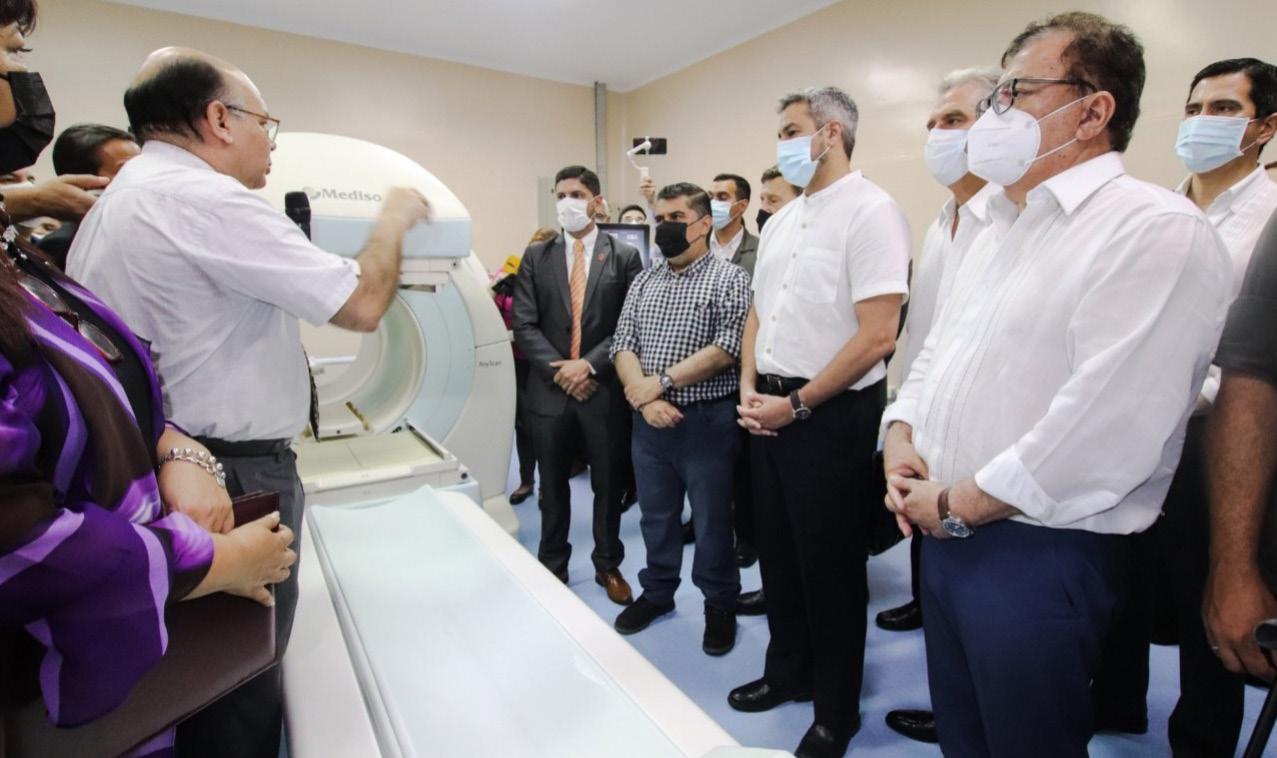
Better screening and treatment to tackle cancer in Paraguay
By Andrea Galindo
mobilized more than €3 million to fight cancer in Paraguay. Technical cooperation funds, as well as extrabudgetary contributions from Japan and the United States of America, have been used to provide capacity building, to train local professionals in the safe and effective use of the necessary machines, and to procure equipment.
In Paraguay, cancer is a leading cause of death and, every year, 12 000 Paraguayans are diagnosed with the disease. Limited equipment and a lack of trained personnel in the country mean that many diagnoses come too late and a third of those diagnosed — roughly 4000 people — do not survive. That figure is set to change, as IAEA support to the country ramps up and Paraguay gets its first public sector positron emission tomography–computed tomography (PET–CT) scanner.
“This PET–CT scanner will, for the first time, bring affordable, quality cancer diagnosis to those most in need. It will have a big impact on our ability to diagnose cancer early and reduce mortalities,” said Mario Fabián Martínez Mora, Director General of the Health Science Research Institute, which received the PET–CT scanner in November 2021.
PET is a modern, non-invasive technique that involves the injection of radiopharmaceuticals into a patient. The radiopharmaceuticals are then traced by the machine for imaging purposes. Thanks to the hybrid nature of the PET–CT scanner, it is possible to produce quantitative three dimensional images to improve medical diagnoses and monitor treatments.
Over the past five years, the IAEA, through its technical cooperation programme, has
“Our objective is to improve the quality of life for cancer patients and improve survival rates. That starts with developing countries’ facilities, human resource capacities, and national coordination strategies for cancer,” said Luis Longoria Gandara, Director of the Division for Latin America and the Caribbean at the IAEA. “In Paraguay, the new PET–CT scanner is the latest in a string of technology transfers and other capacity building efforts for improving diagnostic access and accuracy for efficient therapeutic treatment.”
Equipping to fight cancer
The new diagnostic equipment comes in addition to radiotherapy machines which have already been provided to Paraguay by the IAEA. The IAEA is now also procuring a linear accelerator, or linac, which will become the third such accelerator in the country and will help to provide much needed radiation therapy to cancer patients. According to Paraguay’s Ministry of Public Health and Social Welfare, the country requires a total of seven linacs to meet its treatment needs.
Beyond linacs and scanners, in 2018 Paraguay received a high dose rate brachytherapy system, used in treating cervical cancer, and dosimetry equipment for ensuring radiation doses are sufficient, yet safe. Furthermore, the IAEA provided a gamma probe for lymph node detection and training on its use in detecting and treating breast cancer. Coupled with IAEA capacity building, these efforts have begun yielding results, with a significant reduction in the number of patients on the waiting list for treatment for cervical cancer — Paraguay’s third deadliest cancer after breast and prostate cancers.
28 | IAEA Bulletin, February 2022 Cancer care for all
(Photo: Paraguay’s Radiological and Nuclear Regulatory Authority (ARRN))
Quality assurance
Dosimetry audits for safe and effective radiotherapy treatment
By Joanne Liou
Radiotherapy is required for nearly half of all cancer patients, and the precise delivery of radiation — the amount and the localization — is key to the success of the treatment.
“The accuracy of the dose delivered to cancer patients is directly related to the outcome, both in terms of tumour control and in sparing healthy tissue to the extent possible,” said Jamema Swamidas, Head of the IAEA’s Dosimetry Laboratory. “It is, therefore, extremely important to deliver an accurate dose, not only in terms of quantity, but also to the precise location of the tumour.”
Dosimetry is the science of measuring, calculating and assessing radiation doses, and dosimetry auditing ensures that radiation doses to patients are accurate and delivered with well calibrated machines. While some countries manage their own audit programmes, in those that do not, the IAEA — together with the World Health Organization (WHO) — has, since 1969, provided audit services to independently verify the calibration of radiotherapy units.
The IAEA–WHO audit programme
The IAEA’s Dosimetry Laboratory in Seibersdorf, Austria, performs about 800 to 900 audits of radiotherapy beams per year for more than 130 countries. To date, the service has performed approximately 15 000 radiotherapy beam checks around the world, Swamidas said.
Participating medical physicists provide details about their radiotherapy machines when an audit is requested, and the IAEA sends dosimeters — devices used to measure absorbed doses of ionizing radiation — to radiotherapy facilities or national coordinators for distribution. The dosimeters are then irradiated to a specified dose, similar to how a patient would be treated. Afterwards, the dosimeter is sent back to
the Dosimetry Laboratory for evaluation, where the amount of radiation the dosimeter received is compared with the dose originally stated.
A measurement recorded within five per cent of the specified dose is acceptable. “Anything outside the acceptable range is investigated. We assist hospital medical physicists to resolve any misunderstandings or discrepancies,” Swamidas said. For regular participants, it takes about four to six months to complete the audit, from the application for an audit to the availability of results. However, the turnaround for urgent requests is much faster.
“For over 20 years, we have been benefiting from IAEA–WHO postal dosimetry audits that ensure the quality of basic dosimetry,” said Tatiana Krylova, Head of Medical Physics at the N.N. Blokhin Russian Cancer Research Centre in Moscow.
Developing audit methodology
Through coordinated research projects (CRPs), the IAEA is continuing to develop methodologies for dosimetry audits. “Radiotherapy technology is evolving rapidly,” Swamidas said. “We need to keep developing new methodologies to keep pace with new techniques.”
Last year, the IAEA launched a five-year CRP to verify the dosimetry of high dose rate brachytherapy, a type of internal radiation therapy used to treat gynaecological cancer. “Through this research project, the IAEA will coordinate the development of a methodology to audit the brachytherapy process used in the management of cervical cancer,” Swamidas said. Many low and middle income countries have a high incidence of cervical cancer, and the project builds upon four previous CRPs that have helped develop and disseminate auditing methodologies for radiotherapy techniques.
“Radiotherapy technology is evolving rapidly. We need to keep developing new methodologies to keep pace with new techniques.”
IAEA Bulletin, February 2022 | 29 Cancer care for all
— Jamema Swamidas, Head, IAEA’s Dosimetry Laboratory
Tedros Adhanom Ghebreyesus is the Director-General of the World Health Organization. As a health scholar, advocate and diplomat, Ghebreyesus has first-hand experience in research, operations, and leadership in emergency responses, and served in Ethiopia’s federal government for over a decade as Minister of Health and Minister of Foreign Affairs.

The global agenda on cancer
By Tedros Adhanom Ghebreyesus
We all have friends and family who have lived – and died – with cancer. Cancer is one of the world’s leading causes of death, and its burden is growing. In 2021, the world crossed a sobering new threshold – an estimated 20 million people were diagnosed with cancer, and 10 million died. These numbers will continue to rise rapidly in the decades ahead. And yet all cancers can be treated, some can be cured, and many can be prevented.
Yet care for cancer, like so many other diseases, reflects the inequalities and inequities of our world. The survival of children diagnosed with cancer is more than 80 per cent in high income countries, and less than 30 per cent in low and middle income countries. Likewise, breast cancer survival five years after diagnosis now exceeds 80 per cent in most high income countries, compared with 66 per cent in India and just 40 per cent in South Africa.
Cancer cases are rising most rapidly in poorer countries where comprehensive treatment is generally not available. Over 80 per cent of the 1.3 billion tobacco users worldwide live in low and middle income countries, and less than 15 per cent of low income countries are able to offer cancer care to their populations.
These devastating inequalities remind us that we are failing much of the world. We
will not achieve the target in the Sustainable Development Goals of a one-third reduction in premature mortality from noncommunicable diseases by 2030 without strong political commitment, backed by investment.
It is against this backdrop that we commemorate the partnership between the World Health Organization (WHO) and the IAEA and the launch of IAEA’s Rays of Hope, which is designed to address a persistent inequality in access to radiotherapy.
A Global Response
Rays of Hope is another landmark in the accelerating global response to cancer, founded on universal health coverage and addressing the underlying determinants of health.
Between 30 per cent and 50 per cent of cancers can be prevented by implementing evidence-based prevention strategies against common risk factors like tobacco, alcohol, unhealthy diet, physical inactivity, air pollution and some chronic infections. Many cancers have a high chance of cure if diagnosed early and treated appropriately. As laid out in WHO’s Global Report on Cancer (2020) strategic investments in cancer as part of health system strengthening could save more than 7 million lives by 2030.
30 | IAEA Bulletin, February 2022 Cancer care for all Ι World View
In 2018, WHO called for the elimination of cervical cancer as a public health problem, and almost all countries have now committed to achieving that target, the first time the world has committed to eliminating a cancer.
This dream is made feasible by vaccines against human papillomavirus (HPV), the pathogen responsible for 99 per cent of cervical cancers. And yet these life-saving tools have remained out of reach for many of the world’s poorest: 79 countries that account for two-thirds of the global burden of cervical cancer are yet to introduce HPV vaccines, because of high prices and inadequate supply. WHO has now prequalified four HPV vaccines, improving supply and reducing prices, we have supported 7 governments to introduce HPV vaccines into national immunization schedules, and are supporting others to improve treatment services and palliative care.
Also in 2018, we launched the Global Initiative for Childhood Cancer supporting 50 countries strengthen their capacities including by optimizing health workforce and constructing new cancer centres. More recently, we announced a US$ 200 million partnership with St Jude Children’s Research Hospital in the USA to provide qualityassured medicines to low and middle income countries.
Just last year, we launched the WHO Global Breast Cancer Initiative to reduce deaths from the world’s most commonly-diagnosed cancer
by 2.5 per cent annually, saving an estimated 2.5 million lives by 2040, by empowering women and strengthening cancer control efforts.
These integrated global cancer initiatives are being implemented by more than 200 partners around the globe, including many development banks who have significantly increased their investments in cancer research, prevention and care.
Improving cancer control towards 2030
The devastating impacts of the COVID-19 pandemic go far beyond the disease itself, badly disrupting health systems and hampering access to services and care across the entire health sector. Half of countries report disruptions in cancer screening and treatment. The effects of this will be felt for decades to come.
Getting back on track requires a redoubling of our efforts, based on a foundation of solidarity and partnership and solidarity. On the occasion of World Cancer Day, we call for strengthening national cancer capacity, including by implementing new WHO-IAEA guidance to set up and build capacity for high-quality cancer centres.
Working together, we can write a new chapter in cancer prevention and control.
Millions of lives depend upon it.
“On the occasion of World Cancer Day, we call for strengthening national cancer capacity, including by implementing new WHO-IAEA guidance to set up and build capacity for high-quality cancer centres”
— Tedros Adhanom Ghebreyesus, Director-General, World Health Organization.
IAEA Bulletin, February 2022 | 31 Cancer care for all Ι World View
Improving access to radiotherapy
Fighting cancer in partnership with the IAEA
By the Ministry of Health and Social
Senegal is committed to stepping up the fight against cancer and has made this a priority. To achieve this, strategies have been adopted to strengthen the country’s capabilities in the early detection, diagnosis and treatment of cancer.
To support cancer treatment through radiotherapy, Senegal has acquired four linear accelerators since 2018, of which three are in Dakar and one is in a regional centre.

Along with this, on 30 October 2021 the first stone was laid for what will be the National Oncology Centre.
Senegal’s own efforts are being supplemented by the support it receives from partners, including the International Atomic Energy Agency, in nuclear medicine and radiotherapy.
This cooperation has already made it possible to carry out a number of projects.
These projects have helped participating organizations in Senegal to:
• Increase the number of diagnostic, radiotherapy and nuclear medicine services to meet the needs of the population;
• Strengthen human resource capacities through programmes for training specialists in radiotherapy and nuclear medicine, including some that take place abroad and are made possible by AFRA–IAEA technical cooperation and fellowships; and
• Improve technical facilities to provide better diagnosis and treatment.
Action of Senegal
the National Cancer Control Plan for 2015–2019. The assessment took place between July and December 2020 — virtually, owing to COVID-19 — and was a great success. Building on this, the IAEA has been supporting Senegal as it formulates its new cancer control strategy for 2022–2026.
The main elements of the National Cancer Control Plan for 2022–2026 currently being drafted, which reflect in large part the recommendations that grew out of the assessment, include:
• Supporting the drafting and implementation of a new cancer plan;
• Establishing regional hubs for radiotherapy and nuclear medicine;
• Improving the equipment for diagnosis and treatment at existing units and introducing new techniques in radiotherapy and nuclear medicine;
• Promoting training;
• Upgrading the equipment and facilities in pathological anatomy and cytology laboratories in at least two regions; and
• Drawing up staff regulations for settings where the work involves the use of radiation.
In this context, the ‘Rays of Hope’ initiative, which was launched by the IAEA Director General and is strongly supported by His Excellency the President of the Republic Macky Sall, offers an opportunity for Senegal, and all of Africa, to:
• Expand access to radiotherapy for cancer treatment by making equipment available
32 | IAEA Bulletin, February 2022 Cancer care for all Ι World View
Bolivia and Paraguay to enhance nuclear security at new irradiation facilities
sources, which are considered to be dangerous if not managed safely and securely,” said Elena Buglova, Director of the IAEA’s Division of Nuclear Security, adding that, “we are very committed to support all States in improved physical protection as part of our long-term capacity building efforts in the secure use of nuclear technology.”
Bolivia and Paraguay are finalizing the design, selection and integration of the most appropriate physical protection measures against potential malicious acts at their new irradiation facilities, with support from the IAEA. These facilities are used to irradiate items such as medical devices for sterilization and fruits for the destruction of pest larvae before export.
The facilities use radioactive sources, which could be misused in the wrong hands, and therefore need to be protected. Putting in place physical protection systems is one of the most important milestones in the process of commissioning such facilities.
Bolivia has requested IAEA assistance to enhance the physical protection of a new multipurpose gamma irradiator prior to the delivery of high activity radioactive sources in 2022. “The new gamma irradiation multipurpose complex will contribute to food safety, increasing agro-industrial productivity, food export and preservation, seed improvement and pest control,” explained Hortensia Jiménez Rivera, Director General of the Bolivian Nuclear Energy Agency (ABEN). “Ensuring that the radioactive sources that will be used at the facility are
secure is a priority both for us and the regulatory body.”
Paraguay also requested assistance for the protection of the county’s first irradiator for research on tissue irradiation, blood irradiation, plant breeding and food safety, which is planned to become operational in 2022. Mario José Gutiérrez Simón, Minister and Executive Secretary of the Radiological and Nuclear Regulatory Authority (ARRN) in Paraguay, explained that the country’s first irradiator will help improve medical treatment services in Paraguay. “While the focus is, of course, on development and making these important services available, this cannot be fully achieved without considering the vital aspects of safety and security. The support provided by the IAEA will help us to do that.”
The IAEA sent experts to the facilities under construction and met with key stakeholders to support the establishment of physical protection measures at the sites. The guidance and training for personnel have enabled local experts to design optimized security systems.

“These facilities, once operational, will be using Category 1 radioactive
Regulators and operators in both countries worked closely with IAEA experts to define suitable physical protection systems, including CCTV surveillance, locks, access controls and intrusion detectors, to protect radioactive material against acts of theft and sabotage. This assistance was provided in tandem with support under the IAEA technical cooperation programme to facilitate the transfer of nuclear technology for peaceful uses.
IAEA assistance in nuclear security
Nuclear security focuses on the prevention and detection of, and response to, theft, sabotage, unauthorized access, illegal transfer or other malicious acts involving nuclear material, other radioactive material and associated facilities.
The IAEA assists States, upon request, in enhancing nuclear security by strengthening the physical protection of facilities with high activity radioactive sources, to reduce related security risks. This technical assistance is financed exclusively through the Nuclear Security Fund, in support of activities to strengthen national capacities for using radioactive sources for beneficial purposes for sustained socio-economic development. Countries can identify any assistance needed to support them through the Integrated Nuclear Security Support Plan mechanism.
— By David R. Ek and Muhammad Waseem
IAEA Updates Ι News IAEA Bulletin, February 2022 | 33
Experts from the IAEA and the Centre for Nuclear Technology Research and Development in La Paz, Bolivia, identifying potential security layers around the multipurpose irradiator.
(Photo: Bolivian Nuclear Energy Agency)
IAEA publishes free e-book on nuclear law
“Major challenges continue to face humanity today and can be expected to persist in the future, including food security, health care and management of water resources, together with the need for a cleaner and safer environment,” states IAEA Director General Rafael Mariano Grossi in his chapter. “Legal frameworks enable the use of nuclear technology to address these critical issues.”
The IAEA’s first ever book by global thought leaders on nuclear law has just been published in e-book format, providing free access to a compilation of essays on this highly specialized legal field. Nuclear Law: The Global Debate echoes the tagline of the IAEA’s upcoming First International Conference on Nuclear Law (ICNL2022), to take place in Vienna from 25 to 29 April, and contains articles by leading scholars, policymakers and scientists in the field.

Nuclear law underpins the entire nuclear sector, enabling the safe, secure and peaceful use of nuclear technology for the benefit of humanity. International legal instruments, standards and norms provide the framework under which those operating a nuclear power plant, transporting radioactive material for cancer therapy or experimenting in a laboratory to develop COVID-19 testing kits work.
The edited volume presents a truly global perspective on the current and emerging issues in nuclear law, grouped around its four pillars: nuclear safety, security and safeguards, and civil liability for nuclear damage. The authors trace the origins of legal instruments and practices in the areas of nuclear safety and emergency response, as well as the IAEA’s mandate in nuclear verification. Addressing small modular reactors, the contributors highlight legal issues surrounding deployment of floating power plants and analyse the applicability of the international physical protection obligations to advanced reactor technologies.
Some experts reflect on the successes and challenges of establishing regulatory bodies and national nuclear security regimes, as well as entire national nuclear power programmes. Others consider how liability could be established in a court of law in cases of radiation exposure and how to strengthen the global nuclear liability
regime. Looking forward, some experts explore the role of nuclear law in enabling peaceful uses of nuclear science and technology, including in economic development, climate change mitigation and the achievement of the United Nations Sustainable Development Goals.
In his chapter, Director General Grossi outlines his vision: “to work actively towards making the legal and normative framework we have today as robust as possible; to help States adhere to the laws, standards and norms that keep us all safe and allow us to enjoy the many benefits of nuclear technology; and to make it possible for all those who, together with the IAEA, shape the international nuclear legal instruments of tomorrow to be as proactive as possible.”
The mandate of the IAEA
Depositary of the international legal instruments on safety, security, safeguards and civil liability for nuclear damage, the IAEA is at the heart of the nuclear legal framework and plays a multi-faceted role in the development and implementation of nuclear law. Nuclear law will continue to provide a foundation for harnessing the power of nuclear technology. To ensure that the nuclear frameworks evolve and remain fit for purpose, the IAEA will convene its first ever conference on nuclear law in April, where hardcover copies of the book will be distributed to participants.
— By Inna Pletukhina
Combatting the banana wilt pandemic with nuclear science
Considered the most lethal banana disease in the world, Panama wilt, a kind of Fusarium wilt in bananas, is a killer that is rapidly spreading in Latin America and hurting global supplies of the world’s most popular export banana variety — the Cavendish. Working hand in hand with experts in
Latin America, the IAEA, in cooperation with the Food and Agriculture Organization of the United Nations (FAO), is using nuclear science to combat, manage and prevent the spread of the disease, save livelihoods and ensure food security.
“When the Andean Community reached out to us, we were aware that the condition is serious and that we should use our nuclear expertise to stop any further spread of the disease,” said IAEA Director General Rafael Mariano Grossi.
34 | IAEA Bulletin, February 2022 IAEA Updates Ι News
Bananas are a staple food in much of the region, especially among poorer segments of the population, and are also an important cash crop. Over 84 per cent of bananas are produced by smallholder farmers and supply the domestic markets, while the remaining 16 per cent produced in tropical areas are destined for export.
According to the FAO, the Cavendish banana provides approximately 47 per cent of global banana production and accounts for almost all the bananas exported. If the disease spreads further, economic loss and unemployment is inevitable, scientists say. Indonesia has already seen an estimated US $121 million of economic loss, and Colombia, the fifth largest exporter of bananas in the world, is likely to lose 30 000 jobs and US $800 million of export earnings per year if the disease is not controlled quickly.
In late August 2021, experts and authorities from the Andean Community — Bolivia, Colombia, Ecuador and Peru — reached out to the IAEA when they discovered the continuing spread of the latest variation of the disease, tropical race 4 (TR4), in the region. First reported in Latin America in 2019, in Colombia, it was observed in Peru in early 2021.
“When we found that more than 80 hectares of land in Peru and 250 in Colombia had been affected, Bolivia also started to fear that the
disease could soon reach its banana plantations. It became clear to us, as a community, that our countries need specialized assistance through nuclear techniques and related biotechnologies to overcome the disease and stop its spread in the Latin American region,” said Antonio Bustamante, Research Technician at the National Institute of Agricultural Research of Ecuador, a country exporting the most bananas worldwide.
TR4 is a soil-borne pathogen, meaning that it can survive for decades in the soil and destroy healthy plants grown in the soil, causing crop loss and making the disease difficult to control. With the pathogen found in 20 countries during the past decade, the IAEA is providing support to stop the disease from escalating further.
The Andes taking action against Fusarium wilt disease
The IAEA and the FAO have put together an emergency technical cooperation (TC) project to strengthen international capacity to prevent and contain the disease through surveillance, early detection, genetic resistance and integrated management.

“We use irradiation to modify the plant material to develop disease-resistant varieties, as well as using the nuclearderived technique of polymerase chain reaction (PCR) or DNA sequencing to detect the disease and stop its spread,”
explained Najat Mokhtar, IAEA Deputy
Director General and Head of
the Department of Nuclear Sciences and Applications.
Innovative research and development activities over the past seven years at the IAEA, through the Joint FAO/ IAEA Centre of Nuclear Techniques in Food and Agriculture, have made it possible to deliver tailor-made technical support to fight TR4. Researchers have made significant progress in the use of radiationinduced genetic variation to develop resistance against TR4 in bananas and ongoing studies at the Joint FAO/IAEA Centre in cell and tissue culture are expected to further accelerate the pace of developing genetic resistance in bananas even further.
The best long-term solution to tackle Panama wilt is genetic resistance, said experts at the Joint FAO/IAEA Centre. Through plant mutation breeding, new disease-resistant varieties of the Cavendish can be developed, which has already been seen in China.
Controlling the spread of any disease or virus relies on early and rapid detection, quarantine and containment. The same applies to TR4. By using PCR, scientists can confirm the identity of the pathogen on bananas and verify whether they are diseased. If the pathogen is detected sufficiently early, it can be destroyed straight away, and containment measures can be taken before it infects neighbouring plantations.
“Building on the research and development activities carried out by the IAEA through the Joint FAO/IAEA Centre, the TC programme is now able to provide support to countries whose agriculture is suffering from Fusarium wilt disease. By working together on a global scale, we can build capacities to stop the disease spreading further and avoid a global banana pandemic destroying one of the world’s favourite fruits,” said Hua Liu, IAEA Deputy Director General and Head of the Department of Technical Cooperation.
— By Puja Daya
IAEA Updates Ι News IAEA Bulletin, February 2022 | 35
In 2021, experts saw Fusarium wilt in many banana plantations across Latin America.
(Photo: M. Dita/Biodiversity International, Colombia)
Setting Up a Cancer Centre: A WHO–IAEA Framework

Cancer centres are a major resource in ensuring a comprehensive approach to cancer treatment and its planning. As part of a new roadmap developed by WHO and IAEA to help countries design national cancer control programmes, this publication proposes a framework to develop a cancer centre and/or to strengthen the provision of services in an existing cancer centre. The publication provides the features of multidisciplinary cancer care and details the infrastructure, human resources and equipment for different services. This framework is expected to be used as a guide to implementation, taking into consideration the local context and resources.
STI/PUB/1989, 103 pp., 13 figs; 2022; ISBN: 978-92-0-100422-2; English, 46.00 Euro
Implementation of a Remote and Automated Quality Control Programme for Radiography and Mammography Equipment

provides a framework for the quality control (QC) of radiographic and mammographic imaging systems using remote and automated tools. The methodology provided in this publication is designed to be easy to implement, in order to support initiation of remote and automated QC programmes. It is based on simple, inexpensive test objects and promotes collection of data in a uniform, harmonized manner allowing for intercomparison and benchmarking. These tests are not intended to replace the comprehensive performance evaluation of the radiographic systems by a CQMP. They can, however, detect deficiencies in system performance before they become clinically significant. Furthermore, frequent QC testing promotes a culture of quality in imaging.
IAEA Human Health Series No. 39; ISBN978-92-0-102621-7; English Edition; 54.00 euro; 2021
Introduction of Image Guided Radiotherapy into Clinical Practice

provides guidelines and highlights the milestones to be achieved by radiotherapy departments in the safe and effective introduction of image guided radiotherapy. Recent advances in external beam radiotherapy include the technology to image the patient in the treatment position, in the treatment room at the time of treatment. Since this technology and associated image techniques, termed image guided radiotherapy, are perceived as the cutting-edge of development in the field of radiotherapy, this publication addresses the concerns of personnel in radiotherapy departments as to the preparatory conditions and resources involved in implementation. Information is also presented on the current status of the evidence supporting the use of image guided radiotherapy in terms of patient outcomes.
IAEA Human Health Reports No. 16; ISBN: 978-92-0-103218-8; English Edition; 31.00 euro; 2019
Assessment of Prospective Cancer Risks from Occupational Exposure to Ionizing Radiation
provides guidance for individuals and organizations on the assessment of prospective cancer risks due to occupational exposure to ionizing radiation for prevention purposes. Prepared in collaboration with the International Labour Organization, and with reference to IAEA Safety Standards Series No. GSR Part 3, it describes cancer risk assessment theory, models and methodologies, and offers practical examples of carrying out these assessments. Artificial sources of radiation are commonly used in the manufacturing and service industries, research institutions and universities, and the nuclear power industry. As a result, workers can be exposed to artificial sources of radiation. There are also a significant number of workers, such as underground miners and aircrew, who are exposed to naturally occurring sources of radiation.
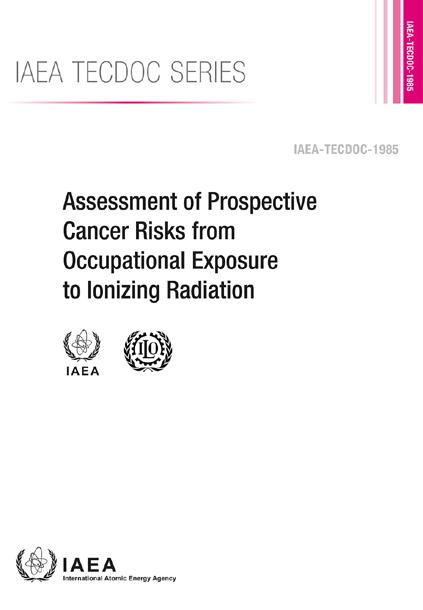
This publication,
IAEA-TECDOC-1985; ISBN: 978-92-0-137921-4; English Edition; 18.00 euro; 2021
For additional information, or to order a book, please contact:
Marketing and Sales Unit
International Atomic Energy Agency
Vienna International Centre
PO Box 100, A-1400 Vienna, Austria
Email: sales.publications@iaea.org
36 | IAEA Bulletin, February 2022 IAEA Updates Ι Publications






22-00185 ISSN 0020-6067 For more information on the IAEA and its work, visit www.iaea.org or follow us on Read this and other editions of the IAEA Bulletin online at www.iaea.org/bulletin
the Global Debate






























25–29 April 2022




















Vienna, Austria

International Conference on
First
#ICNL2022 22-00013E


































 By Lenka Dojcanova
By Lenka Dojcanova









 By Lisa Berthelot and Giovanni Saporiti
By Lisa Berthelot and Giovanni Saporiti





























































